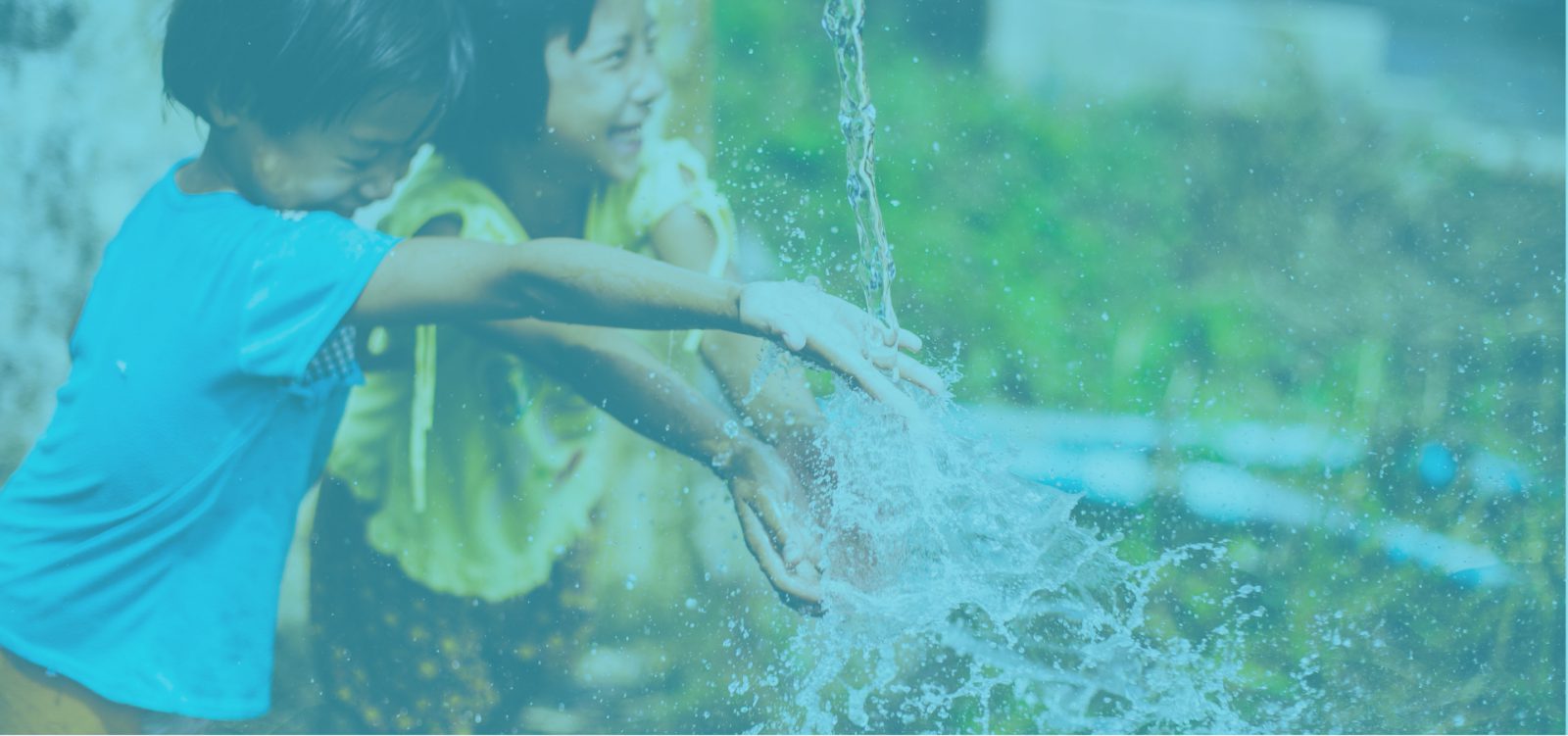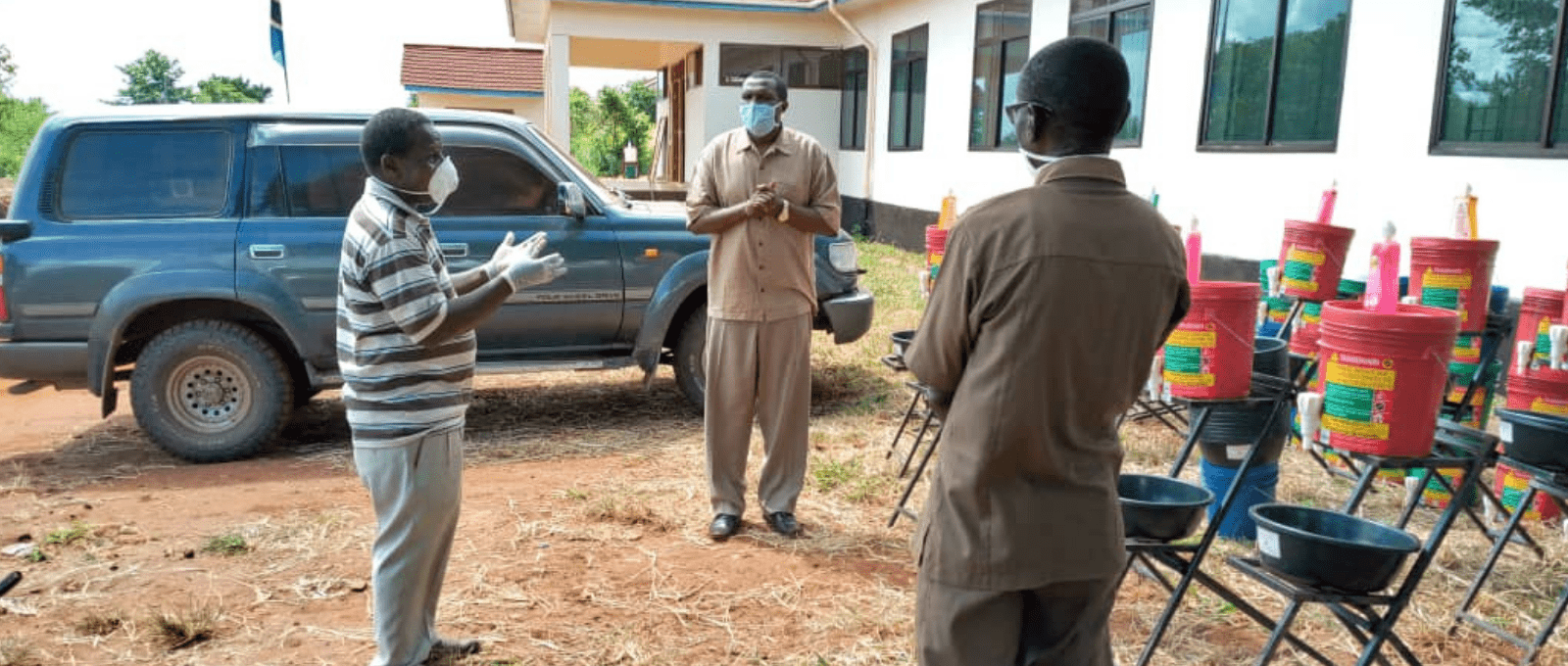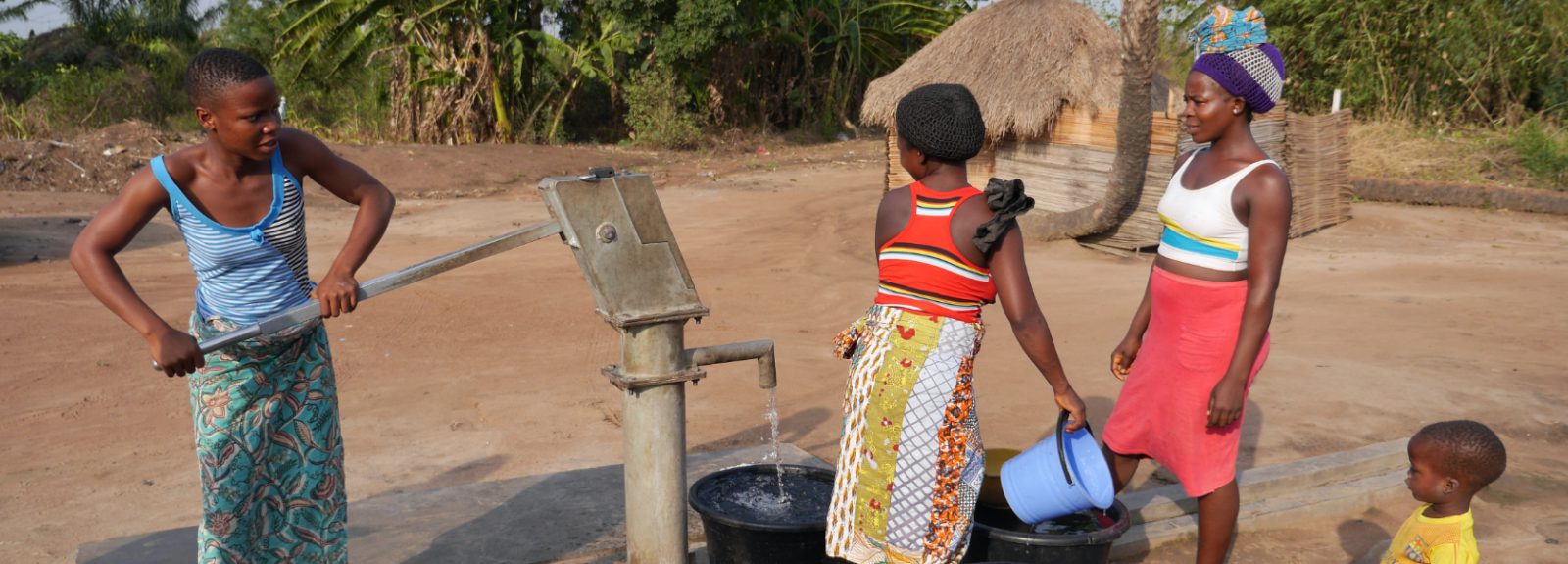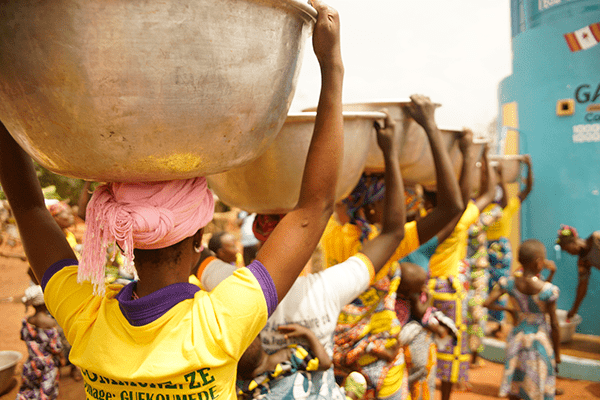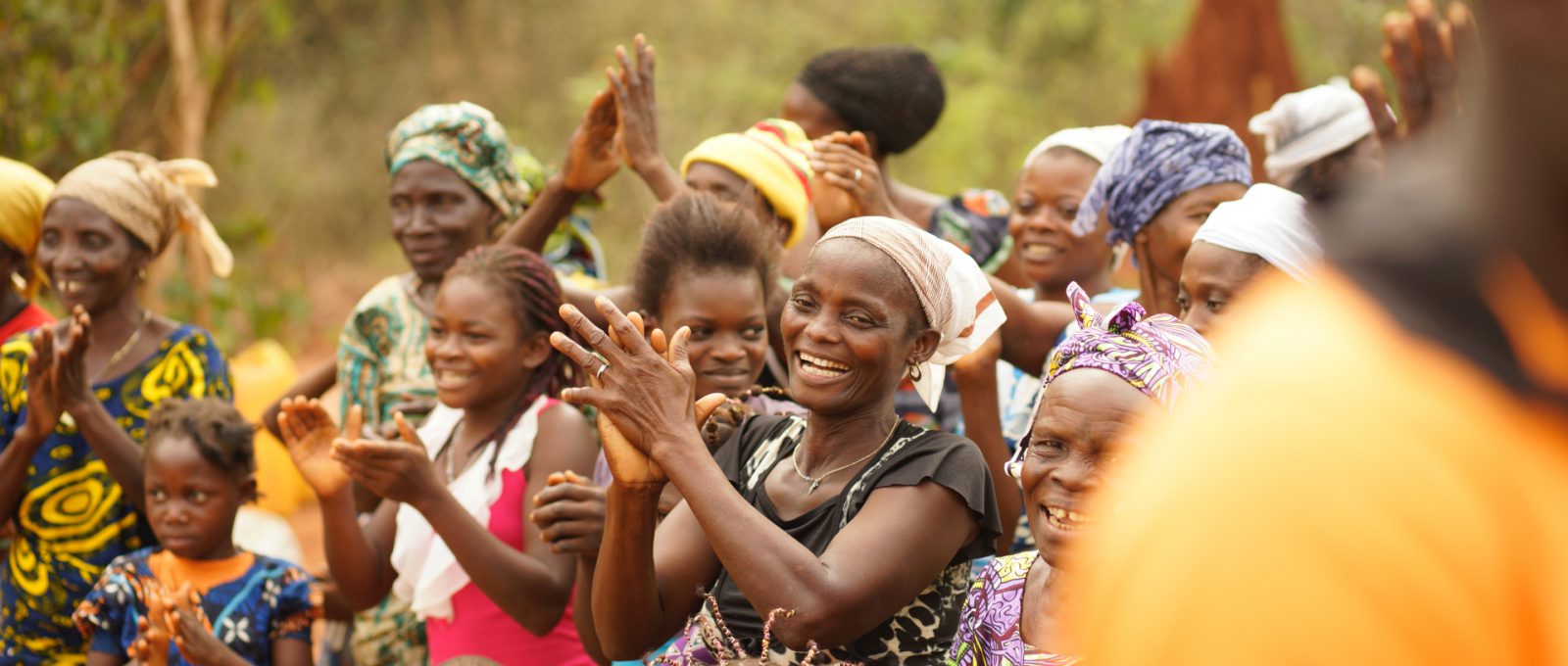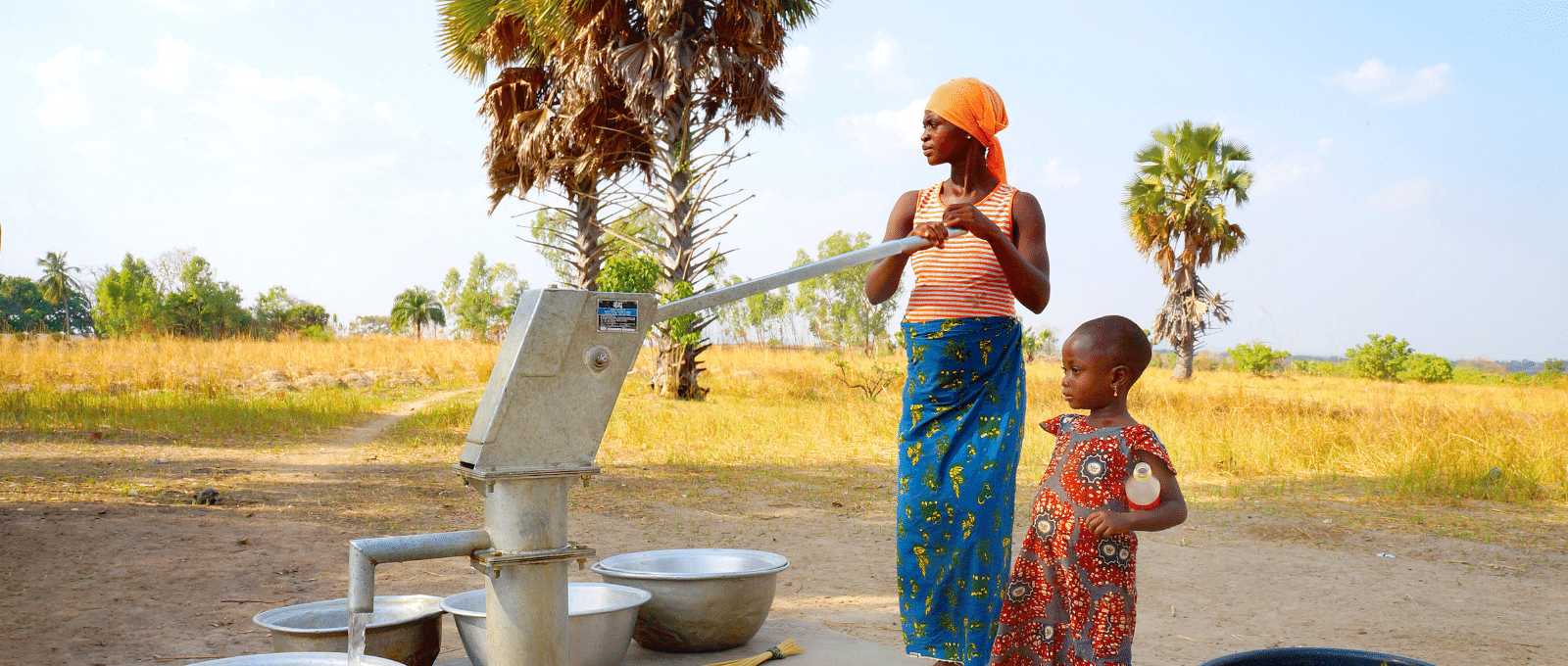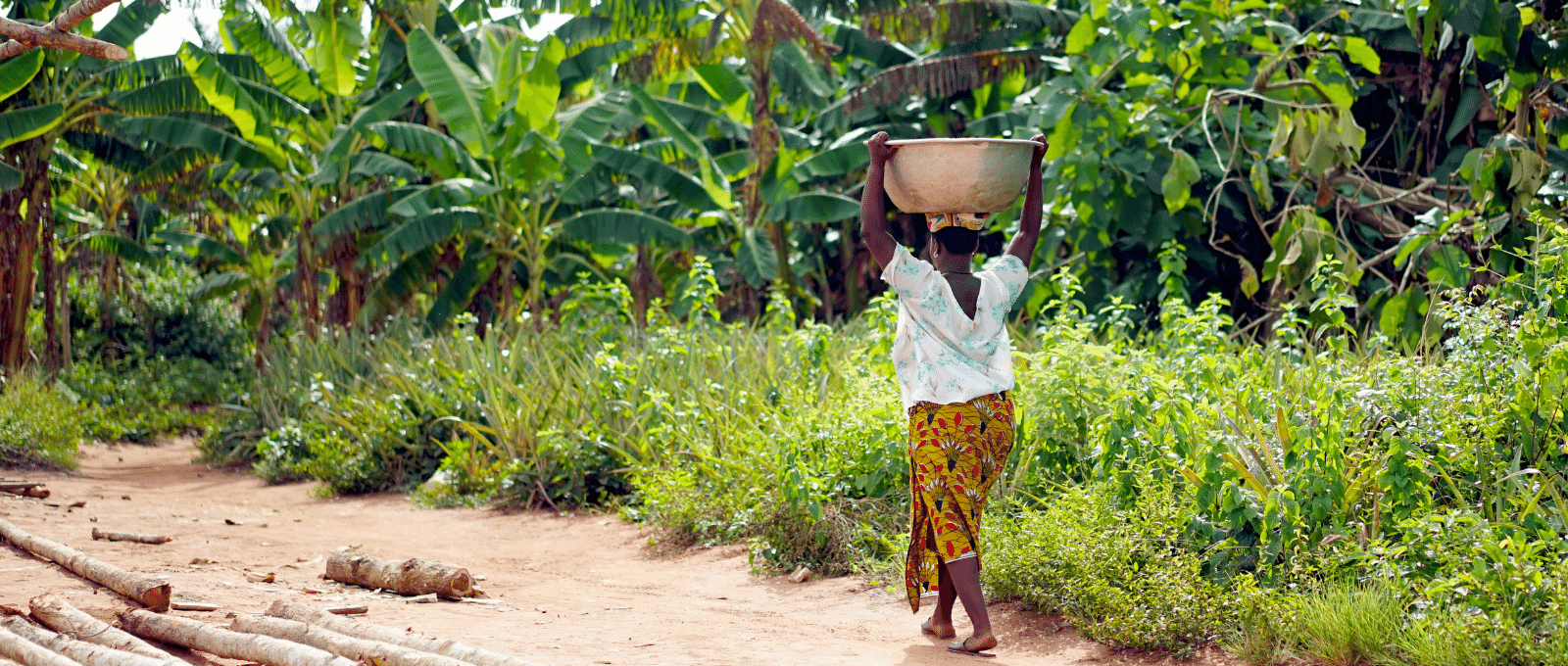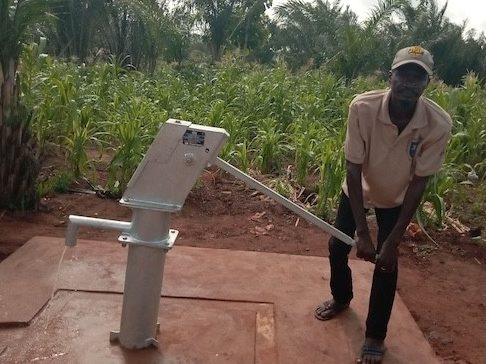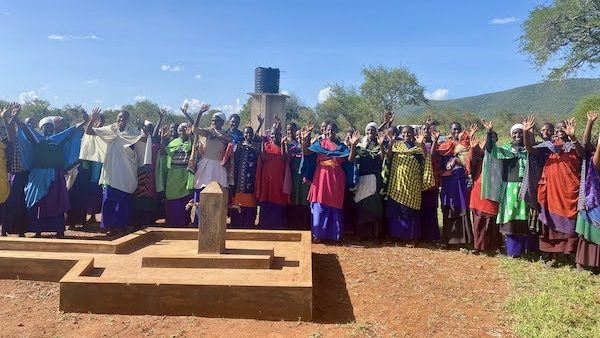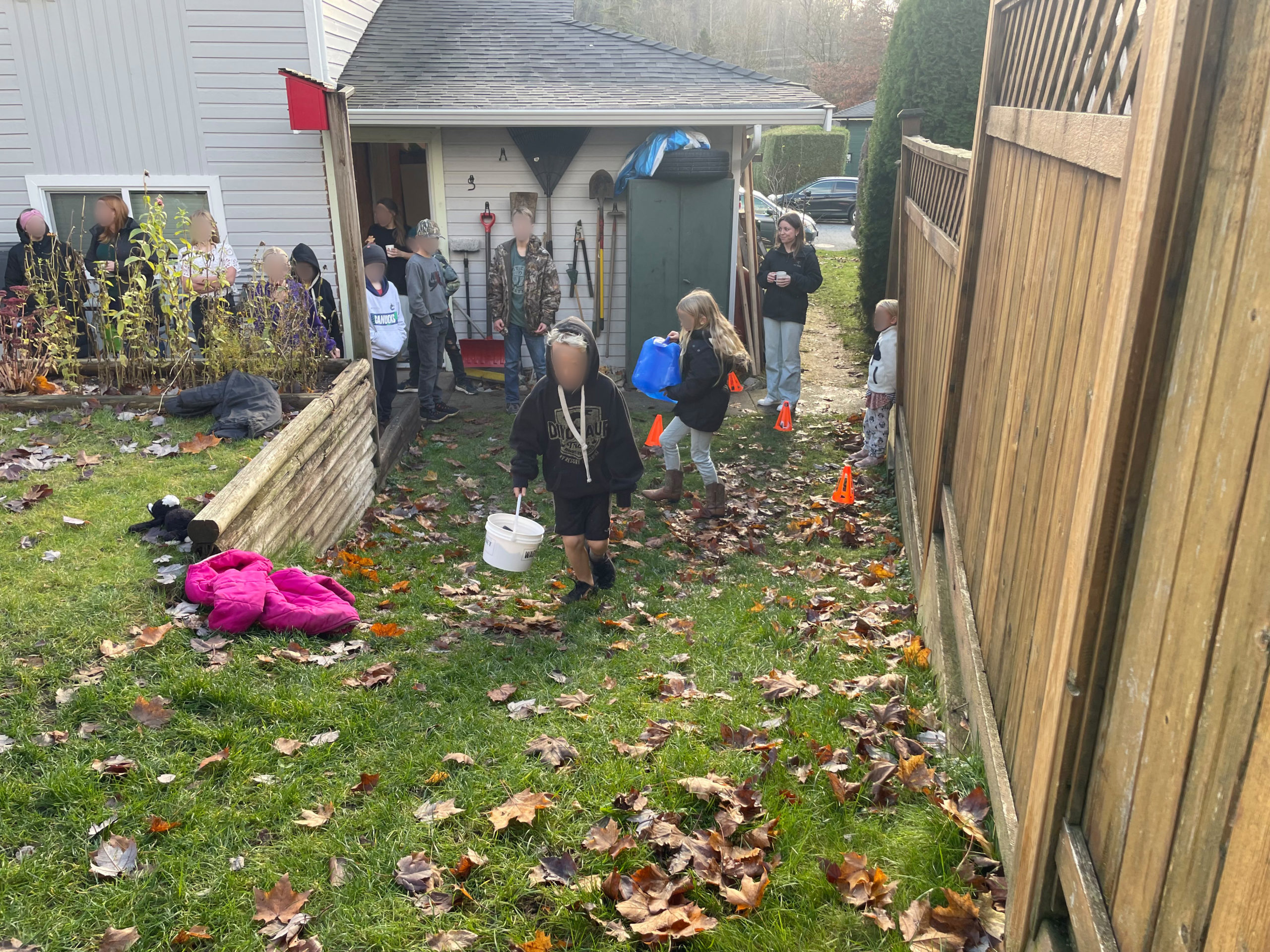A Global Crisis
Water is essential to life. It’s a basic human necessity. Yet, almost 1 in 9 people on the planet right now still don’t have access to safe water.
844 million people are currently forced to use dirty, bacteria-infested water that makes them sick and robs them of their time, dignity, health, right to education, and the opportunity to live an abundant life. More than 840,000 are estimated to die each year from diarrhea as a result of unsafe drinking-water, sanitation and hygiene. For many children, it’s a death sentence.
being a mother in a remote village where there is no access to clean water sources anywhere. All you have is a dirty stagnant stream a few hours away, being shared by livestock to cook, drink and use for your daily activities. You have no other option but to go with your eldest daughter every morning, along with a 40lbs yellow jerry can, to fetch just enough water for your family each day.
Instead of being in school, your daughter walks for hours in the blistering sun, at great risk to her safety, carrying a water jug that weighs almost as much as she does. The worst part is that the water she brings home is dirty and contaminated, with all kinds of bugs that constantly make you and your family sick.
Where you come from, children in your village die every month from waterborne illnesses. Your local witch doctor promises to heal you but nothing is happening.
You feel hopeless with this injustice and witness those around you engaging in destructive behaviours. This physical, social and spiritual brokenness makes you long for hope and a better future.
Because you are spending time collecting water and battling illness, you are unable to generate income to support your family.
This isn’t your story. This is the story of millions of women and children (especially young girls) around the world. Can you imagine this as your daily reality?
Help us bring justice to this reality.
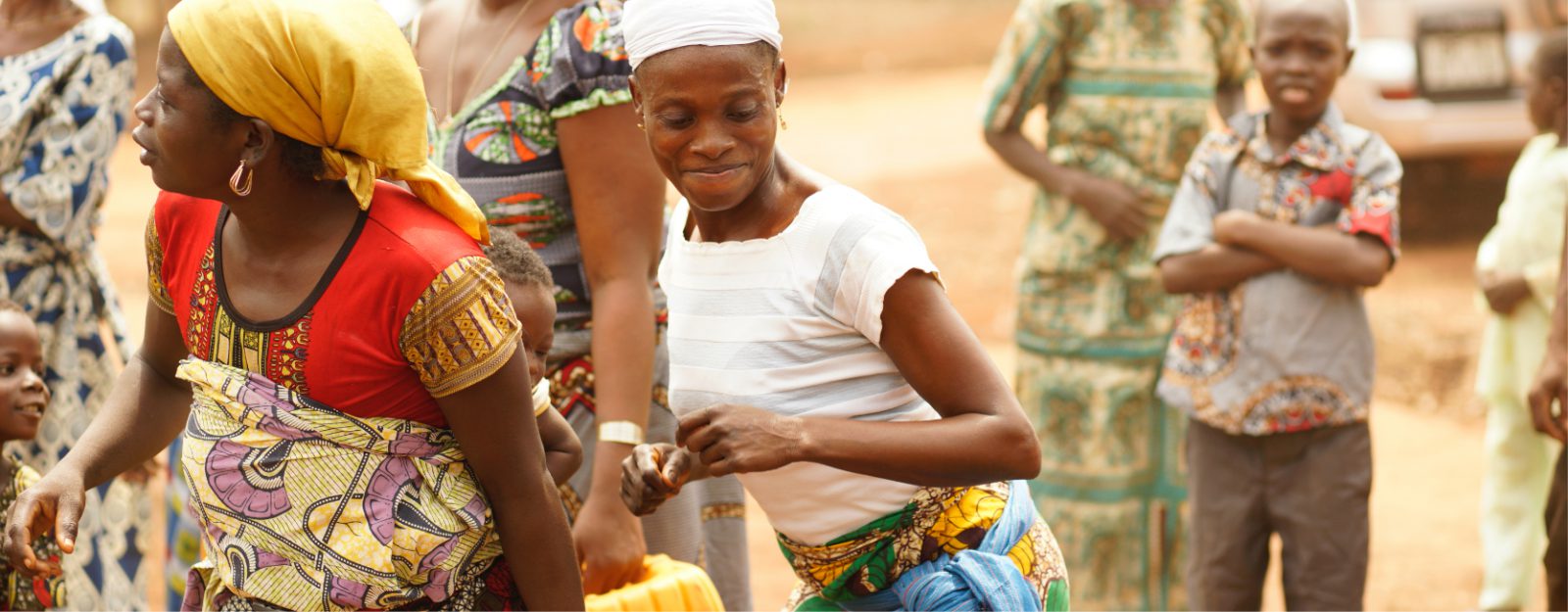
The transformation is truly holistic when a community gains access to safe water for the first time. For many villages, this access marks a new beginning, provides hope for the future and serves as a major milestone in their shared story.
Time
Without
Women and girls around the world spend 200 million hours every day collecting water.
With
Women are now able to care for their families, work, or even start a business. Young girls can attend school and play with other children.
Safety
Without
Women and girls exposed to dangers and vulnerable to exploitation while traveling long distances to fetch water.
With
Stay close to home and no longer vulnerable to being exploited.
Education
Without
1 in 3 schools lacks access to basic water and sanitation. For children getting water or being sick from drinking dirty water, theirs school attendance is significantly affected.
With
More kids able to attend school with less absences due to illness.
Health
Without
Every two minutes a child dies from a water-related disease. Each day, nearly 1,000 children die due to preventable water and sanitation-related diarrheal diseases. More than two million people die every year from diarrhoeal diseases. Poor hygiene and unsafe water are responsible for nearly 90 per cent of these deaths and mostly affect children.
With
Dramatic reduction in sickness.
Nutrition
Without
Frequent diarrhea causes children to not properly absorb nutrients from food, leading to chronic malnutrition.
With
Healthier children are able to grow strong and vibrant.
Economy
Without
Lost economic opportunities from time spent collecting water and battling illness instead of generating income.
With
When water comes from improved and more accessible sources, people spend less time and effort physically collecting it, meaning they can be productive in other ways such as income-generating activities.
Hope
Without
Villagers remain broken in their relationships and with issues of the heart.
With
Villagers understand God’s unconditional love for them.
Give the gift of time, safety, health, education, freedom, and life.
This is a global crisis that affects all of us.
In fact, “Ensure availability and sustainable management of water and sanitation for all” is the Sustainable Development Goal 6 established by the United Nations.

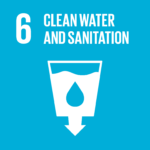
It’s a matter of having the resources to access it and responsibly manage it. There are sustainable, cost-effective solutions to the water crisis and we have the expertise, 20+ year history and vision to bring it to millions more people, but we can’t do it without your help.
Since the beginning, generous partners from all over the world have
-
Provided
3,519
deep-capped water wells -
Provided
3,519,000
people with access to safe water
-
Trained
291,478
people in hygiene and sanitation practices
-
Trained
44,829
people in community health training -
Helped
201,056
people decided to follow Jesus -
Helped
50,090
people learn the basics of their new faith -
Planted
1,226
new churches
For $13.00, you can give a person access to clean water and the Living Water.
Since we have GPS coordinates for each water well, here is a visual footprint of the clean water access points.
4046 – Modoba
Learn More
4002 – Mother Land Secondary School
Learn More
4001 – New IAS/SPC Compound
Learn More
4072 – Nyambo 2
Learn More
4007 – Oboba, 22mls Mbara road
Learn More
4013 – Old Mundri Market
Learn More
4061 – Onjeryma
Learn More
4016 – Payi 3
Learn More
4019 – Payi 4
Learn More
4012 – PDU – Obulu
Learn More
4003 – Police Station
Learn More
4041 – Puturu
Learn More
4004 – Roji A
Learn More
4026 – Roji B
Learn More
4056 – Teliwa
Learn More
4048 – Tukyi
Learn More
4065 – Yeri 2
Learn More
4052 – Lozoh Prison
Learn More
4043 – Lui Displced
Learn More
4057 – Lutunbia
Learn More
4062 – Maborindi
Learn More
4027 – Mandi
Learn More
4011 – Mandi Catholic Church
Learn More
4050 – Mandikini
Learn More
4020 – Matara (Airstrip)
Learn More
4014 – Matara A
Learn More
4024 – Matara B
Learn More
4040 – Matara C
Learn More
4030 – Mbara Joto
Learn More
4031 – Mbara Primary School
Learn More
4006 – Mbara Village
Learn More
4063 – Medewu
Learn More
4010 – Milikodo
Learn More
4015 – Milirugu I
Learn More
4032 – Miri rugu 11
Learn More
4022 – Mirimaja A
Learn More
4025 – Mirimaja B
Learn More
4039 – Hai Salaam 3
Learn More
4038 – Janga
Learn More
4059 – Janga B
Learn More
4053 – Janga B
Learn More
4066 – Jarangala
Learn More
4018 – JIU GOS
Learn More
4017 – JUI SPLA-JIU Government Mundri
Learn More
4029 – Kadegwa
Learn More
4047 – Kasa Alokod
Learn More
4068 – Kediba Prison
Learn More
4051 – Kengye
Learn More
4045 – Kilako
Learn More
4005 – Korogbo
Learn More
4071 – Korowa
Learn More
4070 – Kurkurunwa
Learn More
4049 – Kyidumakaraka
Learn More
4060 – Lalama
Learn More
4009 – Landrawa
Learn More
4028 – Langwa
Learn More
4069 – Lapuru
Learn More
2099 – Zahanati Ngapa Mbuyuni
Learn More
2060 – Zawiani
Learn More
2143 – Zinga Kibaoni Village
Learn More
4036 – Aguburu (PDU 2)
Learn More
0000 – Bahr Olo
Learn More
4073 – ‘Bero’ba
Learn More
4054 – Bilai
Learn More
4075 – Diko 1
Learn More
4074 – Diko 2
Learn More
4076 – Dongoro
Learn More
4064 – Doro
Learn More
4067 – Dosho (Nani)
Learn More
4055 – Gamba
Learn More
4037 – Ghogboua
Learn More
4044 – Goli
Learn More
4021 – Hai Fadil (Catholic Church)
Learn More
4023 – Hai Malakal
Learn More
4042 – Hai Malakia
Learn More
4008 – Hai Matara
Learn More
4034 – Hai Salaam 2
Learn More
2535 – Rupota (B)
Learn More
2430 – Rweje
Learn More
2019 – Sandamkobani
Learn More
2119 – Shule Msingi Majengo – Mkwajuni Village
Learn More
2118 – Shule Msingi Ufundi Mtama Village
Learn More
2065 – Shuleni
Learn More
2149 – Sing’ino Malumba Hospital
Learn More
2068 – Sokoni Litipu Village
Learn More
2159 – Somanga Mtama 2
Learn More
2509 – Stesheni Sekondari
Learn More
2056 – Tandangongoro 1
Learn More
2104 – Tandangonoro 2
Learn More
2071 – Tandika
Learn More
2050 – Tandika Nachunyu
Learn More
2074 – Tandindika Village
Learn More
2026 – Toa Hoja
Learn More
2008 – Tulieni
Learn More
2097 – Uleka
Learn More
2085 – Vijana Kilimahewa
Learn More
2148 – Zahanati Malendego
Learn More
2136 – Ngongowele
Learn More
2522 – Ngumbu Kipara
Learn More
2079 – Ngungungu
Learn More
2493 – Ngunichile
Learn More
2612 – Njawale
Learn More
2169 – Njianne Kisumu
Learn More
2122 – Nsing’ole Kilanjelanje
Learn More
2437 – Ntila
Learn More
2147 – Nyahato Malendego village
Learn More
2491 – Nyambi A
Learn More
2449 – Nyambi B
Learn More
2009 – Nyangao
Learn More
2033 – Nyengedi
Learn More
2483 – Rahaleo
Learn More
2039 – Relwe Mvuleni
Learn More
2096 – Rizaboni
Learn More
2683 – Ruangwa-Kagera
Learn More
2048 – Ruo
Learn More
2034 – Ruo Mission
Learn More
2464 – Rupota
Learn More
2477 – Nanjuva
Learn More
2639 – Narungombe
Learn More
2414 – Narungombe
Learn More
2518 – Narungombe Chini
Learn More
2704 – Narungombe Shuleni
Learn More
2058 – Narunyu-Msikitini
Learn More
2466 – Ndangalimbo
Learn More
2172 – Ndende Bombani
Learn More
2173 – Ndende Ndanje
Learn More
2171 – Ndende Shule Ya Msingi
Learn More
2416 – Nditi Village
Learn More
2203 – Ndomondo
Learn More
2452 – Ndomoni
Learn More
2511 – Ndomoni Sekondari
Learn More
2061 – Ndonde
Learn More
2611 – Ng’ Imbwa
Learn More
2697 – Ng’alile (B)
Learn More
2451 – Ngangambo
Learn More
2675 – Ng’Imbwa Mkata
Learn More
2053 – Ngongo
Learn More
2431 – Nammanja B
Learn More
2528 – Nammanja Shuleni
Learn More
2682 – Namtamba
Learn More
2025 – Namtanga
Learn More
2054 – Namtumbula
Learn More
2637 – Nandandara
Learn More
2630 – Nandenje
Learn More
2433 – Nandile
Learn More
2454 – Nandile Juu
Learn More
2041 – Nang’aka
Learn More
2184 – Nangambi (Nasaya-1)
Learn More
2447 – Nangolola
Learn More
2661 – Nangumbu A
Learn More
2662 – Nangumbu B
Learn More
2707 – Nangumbu Mchangani
Learn More
2617 – Nangurugai
Learn More
2685 – Nangurugai Shuleni
Learn More
2665 – Nanguruwe
Learn More
2624 – Nanjaru
Learn More
2442 – Nanjihi
Learn More
2536 – Namatumbusi (B)
Learn More
2444 – Namatunu
Learn More
2420 – Namauni
Learn More
2151 – Namayani Njianne
Learn More
2427 – Nambalapala
Learn More
2626 – Nambilanje
Learn More
2654 – Namichiga (B)
Learn More
2653 – Namichiga A
Learn More
2646 – Namienje
Learn More
2523 – Namikango (B)
Learn More
2632 – Namikulo
Learn More
2648 – Namilema
Learn More
2643 – Namkatila
Learn More
2681 – Namkatila Cheleweni
Learn More
2621 – Namkonjela
Learn More
2691 – Namkonjela B
Learn More
2461 – Namkula
Learn More
2455 – Nammalabhandwa
Learn More
2435 – Nammanga
Learn More
2453 – Nammanga Mtua
Learn More
2512 – Naipanga Sekondari
Learn More
2471 – Naipingo
Learn More
2510 – Naipingo Sekondari
Learn More
2063 – Naitiwi
Learn More
2497 – Nakalonji
Learn More
2530 – Nakalonji Kanisani
Learn More
2532 – Nakalonji Shuleni
Learn More
2413 – Nakingombe 2
Learn More
2133 – Nakiu
Learn More
2440 – Nalengwe
Learn More
2507 – Nalengwe B
Learn More
2534 – Nalengwe-Nanondondo
Learn More
2656 – Namakonde Shuleni
Learn More
2439 – Namapwia
Learn More
2517 – Namapwia Sekondari
Learn More
2154 – Namatandi
Learn More
2180 – Namatewa 2
Learn More
2204 – Namatula A (Muungano)
Learn More
2205 – Namatula B
Learn More
2476 – Namatumbus
Learn More
2421 – Mtimbo
Learn More
2609 – Mtimbo Ruangwa
Learn More
2689 – Mtimbo-Mjimwema
Learn More
2013 – Mto Mkavu
Learn More
2176 – Mtopela Village
Learn More
2112 – Mtua Kwa Dokta
Learn More
2109 – Mtua Nyerere Village
Learn More
2090 – Mtua Secondary
Learn More
2162 – Muungano
Learn More
2036 – Mvuleni
Learn More
2426 – Mwandila
Learn More
2457 – Mwenge
Learn More
2644 – Nachikalala
Learn More
2640 – Nachinungo
Learn More
2091 – Nachunyu Tandika village
Learn More
2463 – Nagaga
Learn More
2084 – Nagiriki B
Learn More
2498 – Nahimba
Learn More
2663 – Mtawilile
Learn More
2419 – Mtepeche
Learn More
2608 – Mpara
Learn More
2051 – Mpembe
Learn More
2005 – Mpenda
Learn More
2210 – Mpiruka 1
Learn More
2211 – Mpiruka 2
Learn More
2213 – Mpiruka 4
Learn More
2214 – Mpiruka 5
Learn More
2215 – Mpiruka 6
Learn More
2216 – Mpiruka 7
Learn More
2614 – Mpumbe
Learn More
2516 – Mpute
Learn More
2116 – Mputo
Learn More
2044 – Msing’ole
Learn More
2081 – Msiondoke
Learn More
2024 – Msipite
Learn More
2671 – Mtakuja
Learn More
2698 – Mtakuja Ziwani
Learn More
2035 – Mtama Secondary
Learn More
2166 – Mtandango
Learn More
2436 – Mtawatawa
Learn More
2200 – Mkotokuyana 01
Learn More
2201 – Mkotokuyana 02
Learn More
2615 – Mkowe
Learn More
2474 – Mkukwe Village
Learn More
2107 – Mkupama
Learn More
2106 – Mkupama Shule
Learn More
2446 – Mkurupilo
Learn More
2619 – Mkutingome
Learn More
2678 – Mkutingome Shuleni
Learn More
2047 – Mkwajuni
Learn More
2117 – Mkwajuni Kilimahewa A village
Learn More
2694 – Mkwana
Learn More
2007 – Mmangawanga
Learn More
2610 – Mmawa
Learn More
2022 – Mmoa
Learn More
2673 – Mnacho Sekondari
Learn More
2525 – Mnero Hospital
Learn More
2432 – Mnero Miembeni
Learn More
2113 – Mnimbila
Learn More
2023 – Mnyele
Learn More
2001 – Mihande (Mlandizi)
Learn More
2037 – Mihongoni
Learn More
2468 – Milui
Learn More
2032 – Mingoyo
Learn More
2076 – Mingumbi Joblesi
Learn More
2155 – Mingumbi Kililima
Learn More
2146 – Mitole Secondary
Learn More
2145 – Mitole Shule Ya Msingi
Learn More
2174 – Mitole Songosongo
Learn More
2144 – Mitole Village
Learn More
2607 – Mitope
Learn More
2714 – Mitope Mivinjeni
Learn More
2526 – Mituguru
Learn More
2441 – Mitumbati
Learn More
2480 – Miumbuti
Learn More
2627 – Mkaranga
Learn More
2459 – Mkatapori
Learn More
2428 – Mkoka
Learn More
2513 – Mkoka Sekondari
Learn More
2465 – Mkonjera
Learn More
2659 – Mbecha – Ng’Uni
Learn More
2418 – Mbondo
Learn More
2496 – Mbondo Sekondari
Learn More
2520 – Mbondo Shuleni
Learn More
2425 – Mbute
Learn More
2481 – Mbuyuni
Learn More
2622 – Mbuyuni 2
Learn More
2424 – Mchangani
Learn More
2690 – Mchangani-Namitumbati
Learn More
2658 – Mchenga Nyumba
Learn More
2027 – Mchinda
Learn More
2475 – Mchonda
Learn More
2434 – Mibondo
Learn More
2077 – Michehe
Learn More
2669 – Michenga A
Learn More
2670 – Michenga B
Learn More
2684 – Michenga Shuleni
Learn More
2142 – Miguruwe
Learn More
2178 – Miguruwe Shule Ya Msingi
Learn More
2018 – Mihambwe
Learn More
2494 – Malule
Learn More
2003 – Malungo
Learn More
2629 – Mandarawe
Learn More
2489 – Mandawa
Learn More
2004 – Mandwanga
Learn More
2674 – Manokwe
Learn More
2709 – Manokwe Shuleni
Learn More
2473 – Mapambano
Learn More
2651 – Mapambano Mkuti
Learn More
2521 – Mapochelo
Learn More
2066 – Mapokezi
Learn More
2456 – Marambo B
Learn More
2046 – Masasi (Zahanati)
Learn More
2012 – Masasi ya leo
Learn More
2635 – Matambarale Kusini
Learn More
2652 – Matambarale Muhimbili
Learn More
2020 – Matarawe
Learn More
2031 – Maumbika
Learn More
2417 – Maziwa
Learn More
2603 – Mbangala
Learn More
2043 – Mahiwa
Learn More
2042 – Mahiwa Secondary
Learn More
2038 – Majengo
Learn More
2078 – Majengo A
Learn More
2082 – Majengo Bombani
Learn More
2533 – Majengo Shuleni
Learn More
2531 – Majengo Village
Learn More
2080 – Majengo-llala
Learn More
2073 – Maji Maji Village
Learn More
2445 – Majonanga
Learn More
2664 – Makanjilo
Learn More
2696 – Makanjilo (B)
Learn More
2676 – Makanjiro Sekondari
Learn More
2423 – Makitikiti
Learn More
2443 – Makitikiti Mti Mkubwa
Learn More
2040 – Makonde
Learn More
2052 – Makonde Mtama
Learn More
2029 – Makumba
Learn More
2660 – Malolo
Learn More
2706 – Malolo Mashineni
Learn More
2010 – Likong’o
Learn More
2429 – Likongowele
Learn More
2688 – Likunja
Learn More
2114 – Likwaya Village
Learn More
2217 – Likwela
Learn More
2110 – Lilai
Learn More
2021 – Lilindi
Learn More
2011 – Linoha
Learn More
2492 – Lionja – Mayaka
Learn More
2448 – Lionja B
Learn More
2514 – Lionja Sekondari
Learn More
2655 – Lipande
Learn More
2016 – Lipome
Learn More
2069 – Litipu Secondary School
Learn More
2680 – Liugulu Secondary
Learn More
2713 – Liuguru – Liuguru
Learn More
2062 – Livengula
Learn More
2055 – Maendeleo
Learn More
2487 – Magazini
Learn More
2132 – Mageuzi
Learn More
2505 – Kipara
Learn More
2467 – Kipara Mnero
Learn More
2472 – Kipara Mtua
Learn More
2613 – Kipindimbi
Learn More
2703 – Kipindimbi-Naminga
Learn More
2075 – Kisangi Zahanati
Learn More
2484 – Kitandi
Learn More
2606 – Kitandi Gulioni
Learn More
2705 – Kitandi Namakonde
Learn More
2605 – Kitandi Shuleni
Learn More
2687 – Kitandi-Mkolowondjo
Learn More
2093 – Kitomungu A
Learn More
2094 – Kitomungu B
Learn More
2064 – Kumbaila
Learn More
2638 – Kwapuyu
Learn More
2209 – Libea
Learn More
2458 – Libundu
Learn More
2699 – Lichwachwa
Learn More
2006 – Lihimba
Learn More
2017 – Lihimilo
Learn More
2438 – Imara
Learn More
2657 – Ipingo
Learn More
2057 – Jitegemee
Learn More
2537 – Jiungeni
Learn More
2105 – Juhudi
Learn More
2121 – Kafen Mbwekuru
Learn More
2479 – Kariakoo
Learn More
2628 – Kasim Majaliwa Sec School
Learn More
2002 – Kichangani
Learn More
2502 – Kiegei B
Learn More
2469 – Kihuwe
Learn More
2156 – Kikanda Secondary
Learn More
2167 – Kikanda Shule Ya Msingi
Learn More
2028 – Kikomolela
Learn More
2083 – Kikundi
Learn More
2086 – Kilanjelanje C
Learn More
2120 – Kilanjelanje Shule
Learn More
2500 – Kilimarondo
Learn More
2014 – Kilolambwani
Learn More
2460 – Kimawe
Learn More
2677 – Chinokole Shuleni
Learn More
2604 – Chipunda
Learn More
2519 – Chitunda
Learn More
2616 – Chiundu
Learn More
2482 – Chiwindi
Learn More
2633 – Chunyu
Learn More
2634 – Chunyu-Mtumbini
Learn More
2045 – Dodoma
Learn More
2506 – Farm 15
Learn More
2207 – Farm 17
Learn More
2208 – Farm 17 – 2
Learn More
2524 – Farm 17 Sekondari
Learn More
2486 – Farm 8
Learn More
2015 – Gezaulole
Learn More
2185 – Hongwe (Nasaya-2)
Learn More
2115 – Ida Mnole
Learn More
2462 – Idara Ya Madji
Learn More
2527 – Ikungu
Learn More
2415 – Ilolo
Learn More
2150 – Ilulu Secondary
Learn More
2098 – Amani
Learn More
2095 – Chapwachapwa A
Learn More
2508 – Chekeleni
Learn More
2030 – Cheleweni
Learn More
2067 – Cheleweni ‘B’
Learn More
2059 – Cheleweni Primary
Learn More
2450 – Chemchem
Learn More
2695 – Chibula
Learn More
2667 – Chienjele
Learn More
2650 – Chigombelang’oma
Learn More
2625 – Chikoko Mchangani
Learn More
2623 – Chikwale
Learn More
2470 – Chilaile
Learn More
2666 – Chilangalile
Learn More
2495 – Chimbendenga
Learn More
2641 – Chimbila (A)
Learn More
2642 – Chimbila B
Learn More
2693 – Chingumbwa
Learn More
2422 – Chingunduli
Learn More
2602 – Chinokole
Learn More
3090 – Wikipo Kope
Learn More
3023 – Wokpa
Learn More
3081 – Wome
Learn More
3363 – Woutou
Learn More
3189 – Wuidah
Learn More
3111 – Wukpe
Learn More
3100 – Xeve
Learn More
3482 – Yometchin
Learn More
3259 – Yoro
Learn More
3194 – Yoto Kope
Learn More
3162 – Zeme
Learn More
3227 – Ziapeme
Learn More
3290 – Zikpe
Learn More
3481 – Zogbepime Gbeaho
Learn More
3454 – Zoklinkpe
Learn More
3431 – Zokouve
Learn More
3343 – Zokouve Lomnava
Learn More
3532 – Zolou
Learn More
3197 – Zooti Kpota
Learn More
2490 – Abuja
Learn More
3078 – Tovi Ati Aveneme
Learn More
3123 – Tsevi Kondji
Learn More
3512 – Tsevie Deve
Learn More
3421 – Tsikpe Adebo Bokonohoe
Learn More
3534 – Tsila Kpodji
Learn More
3211 – Tsinigan
Learn More
3225 – Tsravekoe
Learn More
3527 – Vessome
Learn More
3022 – Vokope Agbleve
Learn More
3143 – Vongba
Learn More
3351 – Walide
Learn More
3484 – Watayi Kope
Learn More
3360 – Welou
Learn More
3288 – Wendja
Learn More
3511 – Tota
Learn More
3173 – Toulassi Kope
Learn More
3073 – Toume
Learn More
3353 – Touyeda
Learn More
3085 – Tove Ahoundjo
Learn More
3483 – Tovegan
Learn More
3385 – Tchikpe
Learn More
3458 – Tchikpe II
Learn More
3296 – Tchow
Learn More
3400 – Telouwayi
Learn More
3549 – Terahoe
Learn More
3350 – Toblao
Learn More
3200 – Todome Djossou Kope
Learn More
3217 – Togba
Learn More
3267 – Togble Afeye
Learn More
3202 – Tohouedohoue
Learn More
3254 – Toka
Learn More
3218 – Tokpevia
Learn More
3244 – Tokpli
Learn More
3268 – Tokpli Toume
Learn More
3182 – Tokpo Agbohome
Learn More
3180 – Tokpo Agbonicome
Learn More
3348 – Tomboissi
Learn More
3220 – Tomtoe
Learn More
3170 – Toponi
Learn More
3528 – Tossa Kope
Learn More
3413 – Sara Akpindja
Learn More
3414 – Sara Kpalanda
Learn More
3013 – Segbe
Learn More
3001 – Seminary Togo
Learn More
3406 – Senanouhoue
Learn More
3005 – Senougah Kope
Learn More
3289 – Setekpe
Learn More
3219 – Seva Kope Dolohoe
Learn More
3294 – Sevexo
Learn More
3165 – Sim Kope
Learn More
3087 – Soko Attetedome
Learn More
3451 – Tabalo 1
Learn More
3504 – Talo Gbomaho
Learn More
3206 – Talo Lom-nava
Learn More
3464 – Tchal
Learn More
3358 – Tchalikede
Learn More
3321 – Tchaloude
Learn More
3017 – Tchekpo Agotokpa
Learn More
3361 – Tchevenda
Learn More
3262 – Tchikiri Kope
Learn More
3420 – Neti Kope
Learn More
3116 – Noumadje Kope
Learn More
3215 – Ntchiri
Learn More
3192 – Ogbatanawlou
Learn More
3479 – Okafou
Learn More
3382 – Orphelinat Amouzou Kope (CWFC Orphanage)
Learn More
3410 – Papamda
Learn More
3320 – Pidah
Learn More
3330 – Piliziwede
Learn More
3409 – Pissiyo
Learn More
3357 – Poware
Learn More
3398 – Pya Sekpa
Learn More
3478 – Rodokpe
Learn More
3093 – Sadayame
Learn More
3229 – Sagada Adido
Learn More
3305 – Sagada Gbonvime
Learn More
3287 – Saiyo
Learn More
3098 – Salifou Kope
Learn More
3387 – Sanda Cagbanda
Learn More
3423 – Sara Agoundou
Learn More
3126 – Lili Kope
Learn More
3255 – Loape
Learn More
3016 – Lodo Kope
Learn More
3011 – Logowome
Learn More
3080 – Lomegno Kope
Learn More
3095 – Lonto Zogbe
Learn More
3077 – Lovi Kope
Learn More
3462 – Lwagbal
Learn More
3533 – Madjamakou
Learn More
3370 – Makare
Learn More
3547 – Makouya
Learn More
3376 – Manoekpo
Learn More
3006 – Matchale
Learn More
3315 – Matchatom
Learn More
3535 – Matekpo Anima
Learn More
3301 – Mawugbe Kope
Learn More
3344 – Medetohoe
Learn More
3074 – Meleti
Learn More
3310 – Mgbeadzre
Learn More
3071 – Mihelo Kope
Learn More
3144 – Kpele Bodje
Learn More
3145 – Kpele Tsiko
Learn More
3148 – Kpélé Tsiko Djigbe 2
Learn More
3086 – Kpenou
Learn More
3283 – Kpenzinde
Learn More
3112 – Kpetavekoe
Learn More
3517 – Kpeveganme
Learn More
3516 – Kpevevime
Learn More
3166 – Kpime Seva
Learn More
3443 – Kplele
Learn More
3429 – Kpodji Kope
Learn More
3514 – Kponou Djaveme
Learn More
3338 – Kpota
Learn More
3280 – Lakougno Kope
Learn More
3355 – Lama
Learn More
3433 – Lama Tessi
Learn More
3356 – Lamada
Learn More
3402 – Lambo II
Learn More
3333 – Landro Kope
Learn More
3299 – Lanve
Learn More
3007 – Kouglo Kope
Learn More
3329 – Kouloumi Peulh
Learn More
3359 – Koungouyo
Learn More
3122 – Kounou Kondji
Learn More
3172 – Koutepe Kondji
Learn More
3427 – Kouwodo Kope
Learn More
3099 – Koveto
Learn More
3210 – Kovie Djogbeto
Learn More
3393 – Kovie Kpodji
Learn More
3467 – Kpadjol
Learn More
3488 – Kpakpalakpenou
Learn More
3188 – Kpamba Kope
Learn More
3463 – Kpandjal
Learn More
3459 – Kpanzohoe
Learn More
3399 – Kpatare
Learn More
3181 – Kpategan
Learn More
3536 – Kpedji
Learn More
3339 – Kpegome
Learn More
3155 – Kpele Akata Canane
Learn More
3151 – Kpele Anoum
Learn More
3342 – Klikanhoue
Learn More
3300 – Klologo Kpodji
Learn More
3489 – Klologo Mongome
Learn More
3380 – Klomepui
Learn More
3539 – Koboukouna
Learn More
3347 – Kodomboua
Learn More
3352 – Kodosida
Learn More
3292 – Koepedo
Learn More
3316 – Kogo Kope
Learn More
3340 – Kokouhoe
Learn More
3266 – Koledji Kope
Learn More
3129 – Kolo 1
Learn More
3130 – Kolo 2 Kpovi kondji
Learn More
3136 – Kolo Agblo Kondji
Learn More
3128 – Kolo Ali Kope
Learn More
3131 – Kolo Xliboe
Learn More
3401 – Kongozida
Learn More
3163 – Kotor Kope
Learn More
3327 – Koudjodolo
Learn More
3326 – Koudjoukada
Learn More
3233 – Houevime
Learn More
3002 – Houndjodeke
Learn More
3538 – Hounssouhoe
Learn More
3503 – Iko Arouka
Learn More
3207 – Ikoe Atchou
Learn More
3133 – Isaca Kope
Learn More
3332 – Kabassim Kope
Learn More
3335 – Kable Kope
Learn More
3397 – Kadjada
Learn More
3079 – Kaglo Kope
Learn More
3373 – Kalabe
Learn More
3349 – Kalessouhoe
Learn More
3201 – Kame
Learn More
3309 – Kani Kani
Learn More
3371 – Kannyikpedi
Learn More
3265 – Kanou Kope
Learn More
3383 – Kayade
Learn More
3089 – Keve Zogbepime
Learn More
3110 – Kladjame
Learn More
3214 – Klala
Learn More
3127 – Game Seva
Learn More
3426 – Gandihoue
Learn More
3323 – Gando
Learn More
3187 – Gape Amekpe
Learn More
3176 – Gape Deve
Learn More
3230 – Gape Kpodji
Learn More
3186 – Gape Tsoeta
Learn More
3465 – Garcani
Learn More
3161 – Gbessa Kope
Learn More
3025 – Gnamke Kope
Learn More
3082 – Gnive Toxome
Learn More
3480 – Gotha Adja
Learn More
3015 – Gougoume
Learn More
3331 – Gouyarigadou
Learn More
3411 – Hadeteyo
Learn More
3507 – Hagbakoe Akodessewa
Learn More
3508 – Hagbakoe Avegodoe
Learn More
3004 – Health Centre
Learn More
3003 – Hidome Kpota
Learn More
3174 – Hompou
Learn More
3012 – Djonoukouve
Learn More
3317 – Dogogble
Learn More
3115 – Dossa Kope
Learn More
3295 – Doumde
Learn More
3405 – Douvihoue
Learn More
3279 – Edohoue
Learn More
3412 – Edouhoue
Learn More
3117 – Egbi Kope
Learn More
3257 – Eketo
Learn More
3232 – Fandeglahoue
Learn More
3485 – Faoukpe
Learn More
3096 – Fiogble
Learn More
3072 – Fongbe Boeti
Learn More
3168 – Fotowi
Learn More
3318 – Foudjai
Learn More
3477 – Gaglo Kope
Learn More
3520 – Gakpopeme
Learn More
3167 – Gali Kope
Learn More
3019 – Game
Learn More
3203 – Game Lili
Learn More
3275 – Boko Totsoanyi
Learn More
3198 – Bolou Kpeme
Learn More
3018 – Bolou Vavati
Learn More
3473 – Borle 1
Learn More
3354 – Bouraima Kope
Learn More
3324 – Cocoworo
Learn More
3195 – Dagba Kope
Learn More
3346 – Danchihoe
Learn More
3325 – Dantcho Peulh
Learn More
3243 – Datiho
Learn More
3475 – Dawu
Learn More
3178 – Detideke
Learn More
3545 – Dipoutadjole
Learn More
3546 – Diwande Peulh
Learn More
3281 – Djaga
Learn More
3345 – Djangome
Learn More
3432 – Djato Kope
Learn More
3258 – Djidowou
Learn More
3234 – Djogbe Kope
Learn More
3140 – Aveta Sadome
Learn More
3497 – Awagome
Learn More
3114 – Awoudje Kope
Learn More
3260 – Aya Kope
Learn More
3076 – Azon Kope
Learn More
3193 – Babou
Learn More
3108 – Badja Mondji
Learn More
3298 – Badjenokpo Koumedopeme
Learn More
3221 – Badokpo
Learn More
3282 – Bafayi
Learn More
3224 – Banou Awesso Kope
Learn More
3222 – Banou Kpota
Learn More
3297 – Barnade Kope
Learn More
3185 – Basse 2
Learn More
3184 – Basse Adjido
Learn More
3190 – Basse Gnamessi
Learn More
3313 – Bayedje
Learn More
3408 – Bebeda
Learn More
3216 – Blakpa
Learn More
3472 – Blindo
Learn More
3302 – Atiye kope
Learn More
3304 – Atohoe
Learn More
3146 – Atti Touwi
Learn More
3075 – Attissogbi Kope
Learn More
3158 – Attiyi
Learn More
3435 – Ave Kondji Bethel
Learn More
3191 – Avegodoe
Learn More
3457 – Avessoume
Learn More
3141 – Aveta Aho Kope
Learn More
3138 – Aveta Centre
Learn More
3139 – Aveta Djogbedji
Learn More
3125 – Assogba (Assagbo) Kope
Learn More
3179 – Assouma Kondji
Learn More
3269 – Atahonou
Learn More
3407 – Atchankedji
Learn More
3404 – Atchohoue
Learn More
3341 – Atidjeme
Learn More
3231 – Atidome
Learn More
3097 – Atikoloe
Learn More
3183 – Atikpai
Learn More
3417 – Alou Kope
Learn More
3522 – Alouenou Azanvedji
Learn More
3521 – Alouenou Djossou Kope
Learn More
3518 – Aminoupeme
Learn More
3091 – Ando Avedje Segla Kope
Learn More
3147 – Ando Bebo
Learn More
3118 – Ando Gboloba
Learn More
3164 – Ando Hetowui
Learn More
3169 – Ando Kpegnui
Learn More
3419 – Aneve
Learn More
3476 – Animabio
Learn More
3014 – Anyave
Learn More
3205 – Asrama Centre
Learn More
3285 – Asrama Lycee
Learn More
3276 – Asrama Vodome
Learn More
3284 – Asrame Lom-nava
Learn More
3550 – Assahoun
Learn More
3121 – Assahoun Kpowui
Learn More
3024 – Assi Kope
Learn More
3175 – ASSO Atchanve
Learn More
3107 – Agove
Learn More
3548 – Agrona Kope
Learn More
3322 – Ahodo
Learn More
3447 – Ahualihoue
Learn More
3334 – Akakpo Kope (Dokpe)
Learn More
3204 – Akakpohoue
Learn More
3235 – Akama Titoe
Learn More
3236 – Aketehui
Learn More
3009 – Akikotiomey
Learn More
3307 – Aklatso Kope
Learn More
3094 – Akogoe Kope
Learn More
3495 – Akotiya
Learn More
3208 – Akpaka Abaledjo
Learn More
3523 – Akplan Kope
Learn More
3314 – Alabati
Learn More
3251 – Alati Marche
Learn More
3113 – Ali Kpodji
Learn More
3425 – Alibetime
Learn More
3372 – Alignon Kondji
Learn More
3134 – Alladji Kope
Learn More
3328 – Agbamsoda
Learn More
3319 – Agbandao
Learn More
3278 – Agbelouve Atchantigome
Learn More
3226 – Agbelouve Atsakpoe
Learn More
3132 – Agbelouve Gadzepe
Learn More
3171 – Agbeveme
Learn More
3021 – Agbleve
Learn More
3434 – Agbodjekpo Benoit Kope
Learn More
3209 – Agbodjene
Learn More
3008 – Agbossoukope
Learn More
3256 – Agbozoume
Learn More
3291 – Agbui Kope
Learn More
3277 – Agebelouve Yesuvito
Learn More
3088 – Agogno Kope
Learn More
3336 – Agokpo
Learn More
3084 – Agome Kpodji
Learn More
3306 – Agopedo
Learn More
3223 – Agossito
Learn More
3496 – Agotohui
Learn More
3120 – Agou Apegame
Learn More
3152 – Adeta Kpotame
Learn More
3153 – Adeta Kpotame Yougon
Learn More
3150 – Adeta Zongo
Learn More
3199 – Adetikope Adewi
Learn More
3101 – Adidome
Learn More
3529 – Adjaro
Learn More
3196 – Adjomi
Learn More
3119 – Adzakpa
Learn More
3312 – Adzinakou
Learn More
3308 – Afekpa
Learn More
3124 – Afiadegnigban
Learn More
3509 – Afidegnigban
Learn More
3364 – Afokponowoe
Learn More
3311 – Afoule
Learn More
3261 – Agadja Kope
Learn More
3083 – Agadji Tete Kope
Learn More
3020 – Agamahe
Learn More
3137 – Agba Kope
Learn More
3160 – Agbalaho
Learn More
3362 – Agbalossi
Learn More
5007 – Huay Khon
Learn More
5008 – Huay Sai Kao
Learn More
5005 – Huey Dong
Learn More
5004 – Khoknamkliang
Learn More
5010 – Maneepruk 2
Learn More
5003 – Non Nak
Learn More
5001 – Nong Kung
Learn More
5009 – Sop Buen
Learn More
5002 – Swang
Learn More
3159 – Abao Kpota
Learn More
3403 – Abatchang
Learn More
3492 – Ablame
Learn More
3103 – Abobo Chive
Learn More
3104 – Abobo Chive Wlome
Learn More
3177 – Abolodji
Learn More
3422 – Adabadji Kondji
Learn More
3502 – Adanka
Learn More
3442 – Adanto Kpodji
Learn More
3149 – Adeta Akorome
Learn More
3154 – Adeta Condome
Learn More
6032 – Kersa Chobe
Learn More
6038 – Kersa Chobe II
Learn More
6024 – Massa Churke
Learn More
6010 – Melbana Arsebele
Learn More
6011 – Melbana Arsebele 2
Learn More
6009 – Melbena Silala
Learn More
6007 – Meyo Arda Jila
Learn More
6037 – Ola Kunbi
Learn More
6013 – Olla Bidu
Learn More
6059 – Olla Wako Guyo
Learn More
6052 – Ranch
Learn More
6057 – Rera Fakesa
Learn More
6026 – Sakama-2
Learn More
6053 – Soda
Learn More
6012 – Tesso
Learn More
6033 – Tiro
Learn More
6030 – Wajjuu – At school
Learn More
6029 – Wajjuu – Semero Beda
Learn More
6028 – Wajjuu – Semero Ejara
Learn More
5006 – Baan Mai
Learn More
6058 – Dida Golicha
Learn More
6047 – Didibe Romso (Rameta)
Learn More
6025 – Dokessu
Learn More
6017 – Edi Dembela
Learn More
6020 – Ela Loni
Learn More
6042 – Fakessa
Learn More
6036 – Genbe
Learn More
6044 – Godi Bere 1
Learn More
6005 – Guba Ejersa
Learn More
6018 – Guoro Walensu
Learn More
6045 – Hadid Samaro 1
Learn More
6043 – Hadid Samaro 2
Learn More
6040 – Herelo Dhukisa
Learn More
6041 – Herelo Elman Salo
Learn More
6021 – Hidi Preparatory
Learn More
6049 – Hidi Romso (Fulo 1)
Learn More
6048 – Hidi Romso (Fulo 2)
Learn More
6050 – Iresa – Dawe
Learn More
6023 – Kebele Melbena
Learn More
6035 – Kenkelcha
Learn More
1135 – Zoungbo
Learn More
1430 – Zoungbonou – Zogo
Learn More
1019 – Zounkpa(Zeko)
Learn More
8066 – Zounnou
Learn More
1106 – Zounonko
Learn More
1333 – Zounwito
Learn More
8149 – Zouvessehoue
Learn More
6022 – Aden Gure
Learn More
6034 – Ame Serba
Learn More
6051 – Arda Wele – Guda Ana
Learn More
6046 – Arduba Adi
Learn More
6008 – Baha Ejenji
Learn More
6015 – Beha Tumtu
Learn More
6054 – Belbelete
Learn More
6055 – Belebelete – Haro
Learn More
6027 – Bokokesa
Learn More
6031 – Boku Diban Diba
Learn More
6019 – Dhoxu Olgodana
Learn More
6056 – Dhudhuksa 3
Learn More
6039 – Did Mega
Learn More
8182 – Zebou Ahohoue Bar
Learn More
1550 – Ze-Dokota
Learn More
1286 – Zinvie Agbolomey
Learn More
1281 – Zinvie Centre
Learn More
1234 – Zogbadje
Learn More
1688 – Zogba-Gahou
Learn More
1862 – Zonge – Koukouangou
Learn More
1894 – Zongo (Glazoue)
Learn More
7793 – Zonmagbohoue
Learn More
8073 – Zonmon
Learn More
7761 – Zouhoue Aligoudo (Houegbo)
Learn More
1268 – Zoukou Houngon
Learn More
9547 – Zoukoutoudja-Houanzoume (Zogbodomey)
Learn More
1535 – Zoumey-Adjakomey
Learn More
1468 – Zoundehahoue
Learn More
1461 – Zoundehoue
Learn More
1563 – Zoundetomey
Learn More
1049 – Zoundja
Learn More
1083 – Zoundjakpevi
Learn More
8824 – Zoungbahou Centre (Djidja)
Learn More
1263 – Yessinonhoue
Learn More
1545 – Yetapo-Colas
Learn More
1687 – Yimporima
Learn More
1458 – Yimporima 2
Learn More
1521 – Yimporima-Orphelina
Learn More
1546 – Yinontche
Learn More
9555 – Yokon – Agbadji
Learn More
9556 – Yokon – Zoungome (Zogbodomey)
Learn More
7819 – Zaagbokpa
Learn More
9311 – Zado-Gagbe (Zogbodomey)
Learn More
8079 – Zagbokpa – Gbelihoue
Learn More
7304 – Za-Kemondji
Learn More
9559 – Zalime-Souroulere (Zogbodomey)
Learn More
9560 – Zalimey Okpe Olouwa (Zogbodomey)
Learn More
1459 – Zankladja
Learn More
1172 – Zannouhoue
Learn More
1482 – Zanyra (Zaira)
Learn More
7263 – Zanzoun Minbame
Learn More
1137 – Zassa
Learn More
1460 – Zebe
Learn More
8203 – Wonko Alafiarou
Learn More
7404 – Wonkoure
Learn More
9172 – Worogui
Learn More
9065 – Worogui Gbekpanin
Learn More
9552 – Wouankon – Guedehoue (Zogbodomey)
Learn More
1079 – Wourokpo
Learn More
1562 – Yakassar
Learn More
1217 – Yakassuyare
Learn More
1108 – Yakiboura
Learn More
1295 – Yalimaro
Learn More
8802 – Yambouan – Bodobaka
Learn More
7554 – Yankpanssou – Goro
Learn More
1071 – Yawa
Learn More
8798 – Yebessi 1 Bas
Learn More
1494 – Yedevie
Learn More
7535 – Yehouhoue
Learn More
7665 – Yenopie
Learn More
1745 – Yerimarou
Learn More
7371 – Yeroumarou (N’Dali)
Learn More
7420 – Yeroumarou 2
Learn More
1220 – Warikpa
Learn More
1702 – Wassanouhoue
Learn More
1052 – Wawata
Learn More
1085 – Wawata Fandji
Learn More
8476 – Wawata Fanmey (Ear)
Learn More
9180 – Wedede Beni
Learn More
1873 – Wedji Agbanou
Learn More
1739 – Wedji-Gomin
Learn More
1001 – Weke Honvie
Learn More
7744 – Wekehoue (Zebou)
Learn More
1050 – Welimey
Learn More
1507 – Wessi
Learn More
8761 – Wession Camp Peulh
Learn More
7610 – Windjinnawa
Learn More
8361 – Winnan 2
Learn More
1174 – Winra
Learn More
9248 – Wobekou Gare (Parakou)
Learn More
7405 – Wodora (Sirarou)
Learn More
9362 – Wokou 2 Dan (Djidja)
Learn More
1007 – Wokou Alikpa
Learn More
1105 – Vossa
Learn More
8064 – Vouinkpa Havikpa
Learn More
1591 – Wakite-Tchaloute
Learn More
1592 – Walahade
Learn More
1506 – Wangoum
Learn More
8888 – Wansirou 1
Learn More
1279 – Wari Maro
Learn More
1009 – Valentin’s (Tankpe)
Learn More
1677 – Vedji
Learn More
7093 – Vedji
Learn More
8074 – Vemin – Aga
Learn More
7738 – Venaga (Attogon)
Learn More
1575 – Viba
Learn More
1891 – Vivime
Learn More
8070 – Vodo
Learn More
1212 – Vodounonko
Learn More
1099 – Voko
Learn More
9214 – Volly Centre (Atomey)
Learn More
9215 – Volly Latadji (Atomey)
Learn More
7612 – Vongnigodo
Learn More
9443 – Tossoukpehoue Dotou (Houeyogbe)
Learn More
1399 – Touboutonan
Learn More
9441 – Toui – Gare
Learn More
8212 – Touko Peulh
Learn More
1303 – Touko Sari
Learn More
1532 – Toukoumtouna 2
Learn More
1531 – Toukoumtouna Centre
Learn More
1530 – Toukoumtouna-Camp-Peulh
Learn More
1534 – Toukoumtouna-Marche
Learn More
1193 – Toukountouna
Learn More
9249 – Tourou Alafiarou (Parakou)
Learn More
1613 – Tourou-4-Zongo
Learn More
1037 – Tozounme
Learn More
1823 – Trahinta
Learn More
1125 – Tre
Learn More
1440 – Trinnonhoue
Learn More
7946 – UAC-1
Learn More
7947 – UAC-2
Learn More
1676 – UEEB-Parakou (Sinagourou)
Learn More
1095 – Unipar
Learn More
1520 – Tori Avamey-Azohoue
Learn More
8317 – Tori Bossito Sidonou
Learn More
8208 – Tori Cada Ahohoungbo
Learn More
8209 – Tori Cada Lokossa
Learn More
8207 – Tori Cada Tanto
Learn More
1457 – Tori Gare 1
Learn More
1549 – Tori-Anoum
Learn More
1574 – Tori-Anoum 2
Learn More
1138 – Tori-Cada Gbegoudo
Learn More
1245 – Tori-Gbegoundo
Learn More
1542 – Tori-Gbohoue
Learn More
1543 – Tori-Houedaga
Learn More
1544 – Tori-Kada Lokossa
Learn More
7202 – Tori-Laho
Learn More
1214 – Tori-Lokossa
Learn More
7201 – Tori-Sossoumey
Learn More
1657 – Torom
Learn More
1603 – Tossahoue
Learn More
1732 – Tossouhon
Learn More
8310 – Tossouhoue
Learn More
8539 – Tochi Awokpa Ze
Learn More
8294 – Todjrekandehoue
Learn More
1441 – Toga
Learn More
1711 – Togon
Learn More
1046 – Togoudo
Learn More
1110 – Tohoue
Learn More
1667 – Tohouegnonhoue
Learn More
1602 – Tokekanmey
Learn More
1205 – Toko Bio N’kparou
Learn More
8914 – Toko Bio N’kparou 2
Learn More
1169 – Tokourou
Learn More
1087 – Tokponhoue
Learn More
9212 – Tokponssihoue Adjahou (Atomey)
Learn More
1291 – Tolebekpa
Learn More
1706 – Toli-Tognihohoue
Learn More
1298 – Tomadjihoue
Learn More
7203 – Toovi
Learn More
1450 – Topo Koussouborgou 3
Learn More
1322 – Tori Agbodji
Learn More
1316 – Tori Agomme
Learn More
1428 – Tekonite
Learn More
7666 – Tekonte
Learn More
1519 – Tekpahoute
Learn More
1467 – Tewantienite
Learn More
7059 – Thoui
Learn More
9247 – Tibonan (Parakou)
Learn More
7651 – Tignapeti (Camp Peulh )
Learn More
1415 – Tigninti
Learn More
1429 – Tigninti-Dinoukpaou
Learn More
1541 – Tinanmouti
Learn More
7556 – Tinin Camp Peulh 2 (Bahounkpo)
Learn More
1313 – Tinkou
Learn More
1493 – Tinnoni
Learn More
1427 – Tinvihoue
Learn More
1625 – Titirou-1
Learn More
1626 – Titirou-2
Learn More
8358 – Toboboue (Tori-Soklogbo)
Learn More
1600 – Tobou-Kparou 1
Learn More
1601 – Tobou-Kparou 2
Learn More
1180 – Tobre
Learn More
8316 – Tatonnonkon (Bonou)
Learn More
1481 – Tawantate
Learn More
1317 – Tchabi Sarou
Learn More
1761 – Tchafarga
Learn More
1686 – Tchague
Learn More
9202 – Tchakante Gah Fanni
Learn More
1380 – Tchanga
Learn More
1449 – Tchanwessi
Learn More
1257 – Tchatchou
Learn More
1038 – Tchatéhoué
Learn More
1791 – Tchatienou (Oukobou)
Learn More
1505 – Tchawoussou
Learn More
1624 – Tchedjigon
Learn More
9570 – Tchiheïgon – Koussoukpa
Learn More
1492 – Tchikangou
Learn More
7311 – Tchikpotome
Learn More
1528 – Tchoiaga
Learn More
8799 – Tchokpassi 1
Learn More
7519 – Tchoutchoumbou
Learn More
9612 – Tébirou Kouossa Yahin (Matéri)
Learn More
8199 – Takontieta
Learn More
1825 – Takounta
Learn More
1388 – Tali
Learn More
1590 – Talinta
Learn More
1354 – Tamarou
Learn More
7516 – Tambogre
Learn More
1359 – Tandahota
Learn More
1398 – Tandiaka
Learn More
1757 – Tandjaka
Learn More
1328 – Tangbo Aga
Learn More
1983 – Tanguieta
Learn More
1379 – Tankouari
Learn More
7260 – Tankpa Houessouhoue
Learn More
7261 – Tankpa-Centre
Learn More
1760 – Tanongou
Learn More
1561 – Tansar
Learn More
7262 – Tanta Wassa
Learn More
9308 – Tanwe-Vodje (Zogbodomey)
Learn More
7780 – Tassa Yota
Learn More
8200 – Tatanta
Learn More
8972 – Soligbe Soglohoue
Learn More
1655 – Sombouan-II
Learn More
1319 – Somperekou B
Learn More
8852 – Songoura (Bouanri)
Learn More
1055 – Sonon
Learn More
8304 – Sonou Akouta
Learn More
1656 – Sori
Learn More
7318 – Sotinmey
Learn More
1053 – Soubado
Learn More
7573 – Soudjihoue (Ze)
Learn More
1518 – Sounouhohoue
Learn More
1466 – Sountchirantikou
Learn More
9546 – Sountchrantikou2 (Nati)
Learn More
1685 – Sowanouhoue
Learn More
1353 – Soyo
Learn More
7732 – St Michel (Attogon)
Learn More
7740 – St Michel CEG Dangoudo
Learn More
1216 – Suanon
Learn More
7915 – Tachakonta
Learn More
1675 – Takonta
Learn More
7255 – Sewezonhoue
Learn More
1183 – Seyigonmey
Learn More
1044 – Seyzounhoue
Learn More
7521 – Sikanakani
Learn More
1177 – Sikile
Learn More
1378 – Simisson
Learn More
1701 – Sinahou (Yorou-Worou)
Learn More
8962 – Sinasso – Tourou
Learn More
1246 – Singbome
Learn More
1008 – Sinwoué (Sahe): Ahotome
Learn More
1224 – Sirrarou
Learn More
1121 – Sissekpa
Learn More
1124 – Sissenou
Learn More
9077 – Sobonou Niouli
Learn More
1442 – Sohougohoue
Learn More
7731 – Sohoun
Learn More
1266 – Sokokoubou
Learn More
7268 – Sokoudenou
Learn More
8841 – Sokparou (Kinnou Kparou)
Learn More
1504 – Sokponta
Learn More
1321 – Sedje Centre
Learn More
8338 – Sedjinako (Tori)
Learn More
1426 – Sedjrogande (Actchakame)
Learn More
1027 – Segourou-gah
Learn More
1021 – Sehoun
Learn More
8085 – Sehoun 2
Learn More
7011 – Sehoun Glithohoue
Learn More
7010 – Sehoun-Gbamey (Atinangbo)
Learn More
1033 – Sehoungbato (Sèhougbato)
Learn More
1572 – Sehou-Pehoum
Learn More
1356 – Sekere- Gando
Learn More
1560 – Sekou-Bamey
Learn More
7300 – Sekougourou Camp Peulh
Learn More
1412 – Senahoun
Learn More
1491 – Sepounga
Learn More
1490 – Sepounga – Ferme
Learn More
1077 – Serewondirou
Learn More
7785 – Serou – Camppeulh
Learn More
7786 – Serou Somba
Learn More
7152 – Setto Foursquare
Learn More
1341 – Sakassenou
Learn More
8567 – Samaguenou
Learn More
1059 – Sandilo
Learn More
7741 – Sangan Yenawa
Learn More
1198 – Sangou
Learn More
8823 – Sankpiti Centre (Agouna)
Learn More
1062 – Sanson
Learn More
1559 – Sapara
Learn More
1698 – Sassirou-1
Learn More
1699 – Sassirou-2
Learn More
1700 – Sassirou-3
Learn More
1705 – Sassirou-4
Learn More
1296 – Sasso
Learn More
8189 – Satre Houanhonou
Learn More
7051 – Save (Madina)
Learn More
8158 – Save Depot
Learn More
1346 – Sawolou 1
Learn More
1347 – Sawolou 2 (Gobidjo)
Learn More
8563 – Sedagou
Learn More
1573 – Sedjannanko-Tanta
Learn More
9440 – Pk-Toui
Learn More
1674 – Ployarai-Baoussou
Learn More
7650 – Podji – Les – Monts
Learn More
1654 – Poko-II (Gorgoba)
Learn More
8849 – Poola N’Kparou (Tchatchou)
Learn More
1488 – Porga – Six
Learn More
7517 – Porka
Learn More
9493 – Poste Douane Akarade (Aledjo)
Learn More
8249 – Poti Poti
Learn More
1684 – Potokou-1-Camp-Peulh
Learn More
1696 – Potokou-2 (Camp Peulh)
Learn More
1387 – Pountchitega
Learn More
1188 – Poupoure
Learn More
1746 – Pourari
Learn More
1489 – Pouri
Learn More
7148 – Prekete
Learn More
8065 – Sagbovi
Learn More
1365 – Saka Koubarou
Learn More
7296 – Sakabou Camp Peulh
Learn More
1352 – Sakarou
Learn More
1782 – Oukoutchehhoun
Learn More
9401 – Oukpa Djidja
Learn More
1787 – Oukpatihoun
Learn More
7669 – Oukpeahoun (Oukeahoun Colby)
Learn More
1789 – Oumouankanhoun
Learn More
1790 – Ouorou
Learn More
1785 – Oupouonhoun
Learn More
1154 – Oussa
Learn More
7739 – Oussa (Niaouli)
Learn More
1795 – Outchatienou
Learn More
1073 – Pane
Learn More
1571 – Paouignan-Centre
Learn More
1527 – Paouignan-Dome
Learn More
1652 – Papatia
Learn More
1653 – Papatia-Haut
Learn More
1376 – Paripkare
Learn More
1707 – Passari
Learn More
7765 – Patanti-Owide (Alafiarou)
Learn More
1189 – Peperkou
Learn More
1076 – Petipari
Learn More
1373 – Ouega
Learn More
1375 – Ouenou
Learn More
1783 – Oukotouhoun
Learn More
1256 – Oke Shawa
Learn More
7777 – Okouraro (Korontiere)
Learn More
8652 – Okouta-Idogui (Atokolibe)
Learn More
8961 – Okouta-ilai (Koda)
Learn More
1285 – Okpitirou
Learn More
8362 – Oloudehocon (Oloudehoue)
Learn More
9381 – ONG Betimee (Lizeme)
Learn More
1893 – Oroukoto
Learn More
1020 – Orphanage of Tori
Learn More
1487 – Orphelina – Kpekoute
Learn More
8545 – Orphelinat Hekanme (Ze)
Learn More
1131 – Otele
Learn More
1589 – Ouake-Kpeloude
Learn More
1570 – Ouake-Sonate
Learn More
1526 – Ouassa
Learn More
7513 – Oubirihoun
Learn More
1017 – Ouedo
Learn More
1054 – Nassy
Learn More
7781 – Natieni Mbanta
Learn More
1503 – N’ganlo
Learn More
8104 – N’Gbeho (Agouna)
Learn More
1092 – Niaouli
Learn More
1350 – Niaro Bariba
Learn More
1355 – Niaro Gando
Learn More
7301 – Niekere – Bansou
Learn More
8889 – Nima (Parakou)
Learn More
1223 – Ningoussourou
Learn More
1374 – Nouari
Learn More
7006 – Nouwonri
Learn More
7758 – N’Tchon Oke Loukoutou
Learn More
7756 – N’Tchotche (Agoua)
Learn More
1877 – Ogoudako-1
Learn More
9383 – Oguedue Aouga
Learn More
8969 – Oguigui Camp Peulh
Learn More
7807 – Oke Ola Gangnigon
Learn More
8110 – Oke Otola (Kaboua)
Learn More
1326 – Missebo
Learn More
8222 – Moeobani Igbo Adou
Learn More
9495 – Molade-Akarade (Aledjo)
Learn More
1611 – Mondouro
Learn More
8859 – Mondro Gando (ina)
Learn More
7515 – Monkoton
Learn More
1152 – Monlandjotomey
Learn More
1612 – Montchohoue
Learn More
7778 – Montiman
Learn More
1557 – Morateri
Learn More
7797 – Mougnon Atchago
Learn More
1300 – Mougnon Kossou
Learn More
1396 – Mountibagou
Learn More
7700 – Mousansamou
Learn More
1425 – Moussan – Sanimou
Learn More
1411 – M’parei-Yei
Learn More
1517 – M’pari-Kari
Learn More
9486 – Nallou – Biro
Learn More
1089 – Namatini
Learn More
1397 – Nanebou
Learn More
1424 – Marche de Kouaba
Learn More
7411 – Mareborou
Learn More
7648 – Marebou Camp Peulh
Learn More
8768 – Marekoka-Peulh (Tchatchou)
Learn More
1074 – Maro 1
Learn More
1075 – Maro 2
Learn More
9427 – Maro Auto Gare (Nikki)
Learn More
1032 – Matokou (Dotou)
Learn More
8689 – Mayamon-Issale (Gouka)
Learn More
9430 – Mayoa1 Nikki
Learn More
1090 – Medenahoue 2
Learn More
8980 – Melemele 1 (Frignon)
Learn More
8978 – Melemele Ferme
Learn More
8979 – Melemele N’borko
Learn More
1039 – Metohoue (Avégodo)
Learn More
1136 – Midedji
Learn More
1329 – Migbehoue
Learn More
1386 – Migbehoue 2
Learn More
1280 – Mignomblo
Learn More
7099 – Miniffi
Learn More
9564 – Lokogoudo Awokpa
Learn More
1486 – Lokohoue
Learn More
8263 – Lokossa Gankon (Tori Cada)
Learn More
1479 – Lokovihoue
Learn More
7705 – Lokozoun-Agbodjantogon (Zogbodomey)
Learn More
1781 – Lomou
Learn More
1480 – Lonouhoue
Learn More
9359 – Lotcho-Ahouame (Djidja)
Learn More
1556 – Loukintowin
Learn More
1516 – Madengbe
Learn More
1253 – Madina
Learn More
1120 – Madjalom
Learn More
1289 – Madjatome
Learn More
1410 – Mahounouhoue
Learn More
7787 – Mairie D’Allada
Learn More
1219 – Makohoue
Learn More
1627 – Makrou-Kouande
Learn More
8005 – Mamoussa-Kalahoun (Tanguieta)
Learn More
8251 – Mantchari
Learn More
1784 – Mapoti
Learn More
8328 – Kpossidja
Learn More
1041 – Kpota
Learn More
7510 – Kpota (Houngbagba)
Learn More
1003 – Kpovie
Learn More
7811 – Kpozoun Ahouansrame (Akiza)
Learn More
1385 – Lafibouhoun
Learn More
1890 – Lagbave- Centre
Learn More
1064 – Lahotan
Learn More
1478 – Lahotan 1
Learn More
9176 – Laminou Gbedode (Ouesse)
Learn More
8060 – Landjananko
Learn More
9477 – Lanhouetome – Agehoue
Learn More
1390 – Lapoguehoun
Learn More
1423 – Lehouhoue
Learn More
8083 – Lele
Learn More
1957 – Lema
Learn More
1067 – Lizeme
Learn More
1651 – LJF-Ouidah
Learn More
1158 – Lobagbome
Learn More
1672 – Lodji
Learn More
1622 – Kpindjennafa
Learn More
1555 – Kpingni-Bellevie
Learn More
9213 – Kpinme Sogbossihoue (Atomey)
Learn More
1533 – Kpintikou 1
Learn More
1529 – Kpintikou 2
Learn More
1156 – Kplakacodji
Learn More
1060 – Kplakplahoue
Learn More
9414 – Kplassou-kpe (Zinvie)
Learn More
1623 – Kpledemegon
Learn More
8351 – Kpodjava Fandji
Learn More
7794 – Kpodjehounhoue (Mougnon)
Learn More
1147 – Kpodji
Learn More
8198 – Kpodji Ze (Doutomey)
Learn More
1070 – Kpogbahoue
Learn More
9252 – Kpoglassignon (Save)
Learn More
1671 – Kpohou-2
Learn More
1409 – Kpohounpkahoue
Learn More
1042 – Kpokonouhoue
Learn More
8072 – Kpome
Learn More
7569 – Kpossahoue-Agossouko (Tori)
Learn More
1717 – Kpakpa – Agbagoule
Learn More
1515 – Kpalimata
Learn More
1324 – Kpanroun
Learn More
1252 – Kparisserou
Learn More
1683 – Kpassa
Learn More
8449 – Kpassakon (Tori)
Learn More
1204 – Kpassatona
Learn More
1477 – Kpatago
Learn More
1670 – Kpate-Dassa
Learn More
1116 – Kpaworou
Learn More
9481 – Kpe Kanjitomey
Learn More
9480 – Kpe-Agonkon (Zinvie)
Learn More
1122 – Kpebie
Learn More
1115 – Kperou Mbow
Learn More
1307 – Kpessara
Learn More
8195 – Kpessene
Learn More
8800 – Kpessou – Dagrou
Learn More
8143 – Kpetakpa
Learn More
1817 – Kpetissohoun
Learn More
7834 – Kpetiyeri
Learn More
1650 – Kousantiyinkou
Learn More
1448 – Kousouborgou 2
Learn More
1384 – Koussega
Learn More
1860 – Koussocoingou
Learn More
1407 – Koutadangou 2
Learn More
1775 – Koutagba
Learn More
8759 – Koutagba 2 (Adeohogbe)
Learn More
1820 – Koutchatangou
Learn More
1861 – Koutchatawongou
Learn More
8250 – Kouteboua
Learn More
1826 – Koutengou
Learn More
7643 – Koutitiehou
Learn More
1502 – Koutitihou
Learn More
1456 – Koutitihoun
Learn More
1664 – Koutougou-1
Learn More
1665 – Koutougou-2
Learn More
7779 – Kouya-Tiyotouti
Learn More
1547 – Kpabradoh-Anoum
Learn More
1048 – Kpadjouda
Learn More
8215 – Kpakome (Soclogbo)
Learn More
1663 – Kougnankou Camp Peulh
Learn More
8261 – Koukontibouakou
Learn More
1821 – Koukoua 1
Learn More
8253 – Koukouangou Tchantcho
Learn More
1501 – Koukpahoupa
Learn More
1150 – Koukpakihoue
Learn More
1421 – Kounadorgou 2
Learn More
1454 – Kounanyingou 2
Learn More
1513 – Kounanyingou-Ferme
Learn More
1414 – Kounayingou
Learn More
1586 – Kounkounlounda-1
Learn More
1587 – Kounkounlounda-2
Learn More
1422 – Kounmawarigou
Learn More
8252 – Kountchougou
Learn More
1446 – Kouorou
Learn More
8247 – Koupargoue
Learn More
1514 – Koupehe
Learn More
1439 – Koupetenonkou
Learn More
1447 – Koupetetenon (Perma)
Learn More
8558 – Kouroukarou
Learn More
1621 – Korobororou
Learn More
7400 – Korouborou (Kakara)
Learn More
7322 – Kosso (Paouignan)
Learn More
8951 – Kossou – Tchaourou
Learn More
9550 – Kotokpa-Guedenonhoue (Zogbodomey)
Learn More
8843 – Kotossou Kinnou – Kparou
Learn More
8844 – Kotoubarou Tchatchou
Learn More
8557 – Kotoussi
Learn More
1405 – Kouanadorgou 1
Learn More
1406 – Kouargou
Learn More
1437 – Kouatena Kpeloukali
Learn More
1438 – Kouatena Peulh
Learn More
8365 – Koubengou
Learn More
1419 – Kouberepou
Learn More
1584 – Koudeta-AD
Learn More
1585 – Koudetah
Learn More
8526 – Koudjinnada
Learn More
8248 – Koudogou
Learn More
8201 – Koudogou Tchantcho
Learn More
1383 – Kougnamporhoun
Learn More
1168 – Kinihoue
Learn More
1304 – Kiniwobe
Learn More
8090 – Kinkpandan
Learn More
1143 – Kinmahon
Learn More
1693 – Kinnoukpanou Alafiarou
Learn More
1695 – Kinnoukpanou Mamadoukparou
Learn More
1694 – Kinnoukparou-Babarou
Learn More
1218 – Kinwedji
Learn More
1294 – Kioro
Learn More
1465 – Kladjahoue
Learn More
1058 – Klekpehoue
Learn More
1525 – Klogbodji
Learn More
1024 – Kobrikon’to
Learn More
1202 – Kocoubou
Learn More
7766 – Koda (Alafiarou)
Learn More
7767 – Koda 1 (Alafiarou)
Learn More
7145 – Koko
Learn More
8191 – Kokobe
Learn More
8825 – Kokodoko (Agouna)
Learn More
1251 – Kondourarou
Learn More
1271 – Kakohoue
Learn More
7566 – Kakpohoue (Lissegassoun)
Learn More
1569 – Kalanboh
Learn More
1599 – Kallahouihoue
Learn More
1222 – Kambani
Learn More
1797 – Kanafagou
Learn More
7518 – Kanafagou-Camppeulh
Learn More
8071 – Kangnigon
Learn More
1774 – Kani
Learn More
7663 – Kankerike(Oroubassi)
Learn More
1583 – Kapissaote
Learn More
7546 – Kassouala – Tchaourou
Learn More
1337 – Kegamarou
Learn More
7528 – Kekessa (Tori-Agladji)
Learn More
8219 – Kere
Learn More
7374 – Keri 1 (N’Dali)
Learn More
1786 – Ketoutchieke
Learn More
1173 – Kika
Learn More
8797 – Kika 1- Boussounonkparou
Learn More
1104 – Kindji
Learn More
8218 – Idikotan (Irokowari)
Learn More
8533 – Igbo Ewe
Learn More
1925 – Igbo Idi (Pobe)
Learn More
8133 – Igbo Ikoko
Learn More
7244 – Ikanni Manigri
Learn More
1476 – Imporima
Learn More
1182 – Ina Ferme
Learn More
9436 – Issalebai
Learn More
7341 – Issalou
Learn More
1721 – Issarou
Learn More
8292 – Itaelekpete
Learn More
8216 – Itchedoun – Ayekochile
Learn More
1678 – Itouhoue
Learn More
7771 – Kaakpele Peulh (Sonnoumon)
Learn More
7553 – Kadjola – Tchaourou
Learn More
1171 – Kadjoussa
Learn More
1043 – Kaiteme (Kahitèmè)
Learn More
7948 – Kakakorou (Kakaraconou)
Learn More
1349 – Kakara
Learn More
1311 – Kaki Koka
Learn More
1325 – Houehounzame
Learn More
9013 – Houelohoue Godohou
Learn More
8894 – Houessoutome
Learn More
1016 – Houeto
Learn More
7483 – Houetousa 2
Learn More
1418 – Houinga-Houe
Learn More
7567 – Houlodo-Houedaga (Tori)
Learn More
8516 – Houmgnihedo (Djigbe)
Learn More
7269 – Houndadja
Learn More
1142 – Houndje Sinfeve
Learn More
7790 – Houndjinnawa-Agbegon (Zogbodomey)
Learn More
7742 – Hounga Niaouli
Learn More
1750 – Houngbagba
Learn More
1201 – Houngo
Learn More
8737 – Houngo – Houegoudo
Learn More
7615 – Hounkpevehoue
Learn More
1738 – Hountakon
Learn More
9442 – Hountohoue-Dotou (Houeyogbe)
Learn More
1277 – IBB Oumako
Learn More
9437 – Idera Toui
Learn More
1330 – Hon
Learn More
9166 – Honhoun Yahemey
Learn More
9423 – Honme-Djantahoue (Dangbo)
Learn More
1582 – Honoukon (Awessedo)
Learn More
9221 – Hontonnou 2 Toganhoue (Atomey)
Learn More
9220 – Hontonnou Centre
Learn More
1211 – Hopital de Ouedo
Learn More
1244 – Hopital de Tori Gare
Learn More
8952 – Houedaga Kpota (Tori)
Learn More
9561 – Houedazounkpa Agonkessa
Learn More
9609 – Houedazounkpa Centre
Learn More
9562 – Houedazounkpa Houngoudo
Learn More
9329 – Houedja-Houinhi
Learn More
1338 – Houedji
Learn More
1195 – Houedo
Learn More
1315 – Houedo Sonader
Learn More
1179 – Houegan 2
Learn More
8666 – Houegbeissigon (Adomougon)
Learn More
1091 – Houegoudo
Learn More
8589 – Houehounta Kogbodji
Learn More
1160 – Hantchohoue
Learn More
1417 – Haouya-Telokohoue
Learn More
1269 – Haweme
Learn More
7204 – Hayakpa – Fifadji
Learn More
7317 – Hayakpa Aga
Learn More
1445 – Hego
Learn More
1382 – Hetin
Learn More
1339 – Hetinssa
Learn More
9225 – Hevi (Atomey)
Learn More
1128 – Hevie
Learn More
7461 – Hevie Hessa
Learn More
7462 – Hevie Houinme
Learn More
8350 – Hevie Tovo
Learn More
1275 – Hevie Zoungo
Learn More
1030 – Hinlihoue (Klouékanmé)
Learn More
1272 – Hinvi Bossa
Learn More
1249 – Hla
Learn More
8220 – Hlassoue-Glazoue
Learn More
1139 – Hlazounme
Learn More
1400 – Hlepkehoue
Learn More
8264 – Goutchoedouhoue
Learn More
1132 – Goutin
Learn More
7524 – Govi
Learn More
1014 – Govie
Learn More
7746 – Govie – Gbedji
Learn More
9459 – Govie Missebo (Allada)
Learn More
1004 – Guede Codji (Guede Honcon)
Learn More
7611 – Guekoumede
Learn More
9607 – Guelihoue – Houedazounkpa (Ze)
Learn More
1404 – Gueniguehoue
Learn More
9489 – Gueroga Gnoncourocale (Biro)
Learn More
1358 – Guessou Bani Peulh
Learn More
7772 – Guida Bourouli (Sonnoumon)
Learn More
1620 – Guilmaro
Learn More
9177 – Guinirou Centre (Tchaourou)
Learn More
8485 – Hadjinoutome-Agbata (ZE)
Learn More
1259 – Hagbatouhoue
Learn More
1035 – Hahame (Athiémé)
Learn More
1763 – Halagateri
Learn More
1242 – Hangbego
Learn More
1237 – Goro-Banni
Learn More
1568 – Goudessar
Learn More
8765 – Goudi Dodonda Gah (Tchactchou)
Learn More
1065 – Gouglahoue
Learn More
8561 – Goukonou
Learn More
1394 – Goulo
Learn More
1023 – Goumarou
Learn More
7988 – Goumarou-2
Learn More
1366 – Goungourou
Learn More
1610 – Gounin-Baka
Learn More
1299 – Gountoeto
Learn More
7755 – Goure Alafiarou (Bahounkpo)
Learn More
1254 – Goure Gbabi
Learn More
8793 – Goure Issa (Badekparou)
Learn More
8771 – Goure Yoroubara
Learn More
1345 – Goure-Dari
Learn More
7773 – Gourman Kparou – Sonnoumon
Learn More
8795 – Gouroubara – Wabou (Kika)
Learn More
8762 – Gousouambou (Tchatchou)
Learn More
1078 – Goussounonkperou
Learn More
1464 – Glo Tanmey
Learn More
1368 – Glo Yekondo
Learn More
1367 – Glo Yekondo Hodonouhoue
Learn More
1088 – Glodjigbe
Learn More
1475 – Glo-Dome Fanmey
Learn More
1015 – Glo-Fanmey
Learn More
7792 – Gnanininhoue
Learn More
1057 – Gninsy
Learn More
1292 – Gninto
Learn More
1159 – Gnonoumondouhoue
Learn More
8971 – Godohou Centre (Atomey)
Learn More
8312 – Gogore
Learn More
1485 – Gokoun
Learn More
7810 – Gomey Azozin (Akiza)
Learn More
7409 – Gomez Kparou
Learn More
8062 – Gomin Tangnigbadji
Learn More
8853 – Gonmo Sorou
Learn More
1170 – Goro
Learn More
7427 – Gorobani 2 (Maregourou)
Learn More
7640 – Gorobani-Yarika
Learn More
1068 – Gbéhoué
Learn More
9568 – Gbehougon1 Koussoukpa
Learn More
7257 – Gbenouhoue
Learn More
9426 – Gberou Gbete (Nikki)
Learn More
1393 – Gbetado
Learn More
1360 – Gbeto Togbomey
Learn More
8774 – Gbeto-Centre
Learn More
1682 – Gbeze
Learn More
1692 – Gbeze-Mouzouhoue
Learn More
8295 – Gblogblo Centre
Learn More
7989 – Gbotohoulin
Learn More
1197 – Gbovie
Learn More
8269 – Gbowele Domasse
Learn More
1133 – Gbozounme
Learn More
1301 – Gendarmerie de Beterou
Learn More
1436 – Gimparma (Orphelina)
Learn More
7944 – Gingourou
Learn More
1126 – Gledji Aga
Learn More
1372 – Glo Agongbe
Learn More
8337 – Glo Fandji
Learn More
8769 – Gbagnambarou – Tchachou
Learn More
7313 – Gbago
Learn More
7229 – Gbaka- Inase
Learn More
7239 – Gbaka Inase Ouere
Learn More
1187 – Gbakpo
Learn More
7945 – Gbanda
Learn More
7990 – Gbandan Centre
Learn More
8764 – Gbankoko Tchatchou
Learn More
1097 – Gbeda
Learn More
1567 – Gbedavo
Learn More
1403 – Gbefadji
Learn More
7737 – Gbegamey (Yehounmehoue)
Learn More
1540 – Gbegaudo-Houndodji
Learn More
1539 – Gbegaudo-Zounhouemey
Learn More
1146 – Gbegbessa
Learn More
7259 – Gbegbessa-Tanta
Learn More
8267 – Gbegledji
Learn More
9062 – Gbegnimbou – Tchachou
Learn More
1066 – Gbegoudo
Learn More
8840 – Gbegoura Kinnou-Kparou
Learn More
1225 – Gah-Doussi
Learn More
1236 – Gah-Sounon
Learn More
1377 – Gakperou
Learn More
1666 – Gamia-Basson
Learn More
1628 – Gamoudarou
Learn More
8855 – Gando Dadia
Learn More
1250 – Gando Baka
Learn More
8856 – Gando Gourou
Learn More
8183 – Gangletomey
Learn More
1141 – Gangnigon
Learn More
7574 – Gangodjame 1 (Ze)
Learn More
1148 – Ganhatin
Learn More
1206 – Gannon
Learn More
9246 – Ganou-Gourou (Parakou)
Learn More
1500 – Gansa
Learn More
1361 – Ganso
Learn More
9490 – Ganso Peuhl (Biro)
Learn More
1178 – Ganve
Learn More
1181 – Gbadegbomey
Learn More
1018 – Gbadjougon
Learn More
9496 – Ferme Difezi Alledjo
Learn More
1026 – Fiarou
Learn More
7258 – Fignonhoun
Learn More
1474 – Fiodessihoue
Learn More
1011 – First Lady’s – Akassato
Learn More
7086 – Fita
Learn More
1036 – Fonkome (Adjaha)
Learn More
1005 – Fonkoumè
Learn More
1145 – Fonsa
Learn More
1538 – Forogou (Tctouna)
Learn More
1306 – Foundation la Servante
Learn More
1566 – Founga-2
Learn More
1305 – Gaah Gbira
Learn More
1056 – Gagberou
Learn More
7407 – Gah – Borou (Komi-Guea)
Learn More
7429 – Gah Dehou
Learn More
9170 – Gah Egor (Tchaourou)
Learn More
1357 – Gah Guessou Somba
Learn More
7754 – Gah Lemagui (Kinnou Kpannou)
Learn More
7753 – Gah Tinin – Bahon Kpo
Learn More
1274 – EPP Hevie
Learn More
1395 – EPP Kanzounpka
Learn More
1435 – EPP Kouatena
Learn More
1402 – Epp Kouatidabirgou
Learn More
9491 – EPP Madjatom (Aledjo)
Learn More
1537 – Epp Sogbe-Kindji
Learn More
1524 – EPP Tigninti
Learn More
7373 – EPP Woasson Sud (Woasson 2)
Learn More
8891 – EPP Zekanme (Dome)
Learn More
8148 – EPP Zouvessehoue
Learn More
1609 – EPP-Zaffe
Learn More
7205 – Erokowari
Learn More
7223 – Ewe 1
Learn More
7466 – Ewe 2
Learn More
1598 – Eyike-Gome
Learn More
1413 – Fafa
Learn More
1081 – Fandji
Learn More
1086 – Fanto
Learn More
1213 – Fassionouhocon
Learn More
8955 – Feremfe Peulh
Learn More
1680 – Engaladebou
Learn More
1420 – EPP Kounadorgou
Learn More
8772 – EPP Affandji (Tori)
Learn More
8735 – EPP Agoua
Learn More
7319 – EPP Azohoue Aliho
Learn More
8857 – Epp Bereke Gando (Gamia)
Learn More
9219 – EPP Bonanhoue (Atomey)
Learn More
7335 – EPP Dassa Centre
Learn More
7568 – Epp Datinonko (Tori)
Learn More
9245 – Epp Derou (Parakou)
Learn More
8794 – EPP Dipko (Kika)
Learn More
1247 – EPP Dossou Some
Learn More
1999 – EPP Dossouhoue
Learn More
1392 – EPP Douaka
Learn More
9319 – Epp Gbaffo-Kpassa (Ouesse)
Learn More
9243 – EPP Guererou Wanrousourou
Learn More
1629 – Eglise N’gbega
Learn More
9474 – Eglise St Jean V. De Mitro (Dango)
Learn More
1163 – Ekindji
Learn More
7806 – Ekpo (Ketou)
Learn More
1040 – Dossouhoué
Learn More
8293 – Dotinkanme
Learn More
8068 – Dove
Learn More
1607 – Drabo-Daho
Learn More
1221 – Dyangou
Learn More
1630 – EA-Soclogbo
Learn More
8205 – EB Bembereke
Learn More
1772 – EB Sedje
Learn More
8981 – Ebb Frignon
Learn More
1581 – EB-Logozohe
Learn More
1608 – EB-Zaffe
Learn More
1344 – Ecole Biblique Peulh
Learn More
1648 – Edahoue-Lokogohoue
Learn More
7804 – Edenou Esseito
Learn More
9211 – Edjikelle Botadji
Learn More
1151 – Efega
Learn More
7769 – Eglimey
Learn More
8308 – Eglimey Noumonvihoue
Learn More
8305 – Eglin Kokouhoue
Learn More
8773 – Eglise Catholique D’Agoua
Learn More
1332 – Dodjonou
Learn More
7246 – Dogue
Learn More
1034 – Doguia (Akodéha)
Learn More
1153 – Dohoucodji
Learn More
1453 – Dokanme
Learn More
1103 – Dokodji
Learn More
1473 – Dokomey
Learn More
7795 – Dokon Awessougon
Learn More
1691 – Dokouihoue (Dannouhoue)
Learn More
1134 – Domasse
Learn More
1230 – Dome Toto
Learn More
1140 – Domefanto
Learn More
1101 – Domegbo
Learn More
1335 – Dongouragourou
Learn More
1028 – Dononrou
Learn More
1348 – Donou
Learn More
1113 – Donsarou
Learn More
1238 – Donsarou 2
Learn More
8258 – Dossahoue
Learn More
1191 – Dossou Some
Learn More
1243 – Djeho
Learn More
1619 – Djeissoukpongon
Learn More
8106 – Djekpedji
Learn More
9089 – Djeminco tomey (Allada)
Learn More
7812 – Djetingon
Learn More
1434 – Djetoe Kpinnou
Learn More
1433 – Djetoue Adandehoue
Learn More
8975 – Djibime Godohou
Learn More
7555 – Djibo Camp Peulh
Learn More
7784 – Djida
Learn More
1472 – Djidomey
Learn More
1444 – Djidonouhoue (Totoehoue)
Learn More
7749 – Djihintohoue
Learn More
1499 – Djisoukpa
Learn More
1649 – Djoklehoue
Learn More
7560 – Djossouhoue
Learn More
1080 – Dodja
Learn More
1287 – Dodja Deguenonhoue
Learn More
1228 – Dodja Kpossouhoue
Learn More
1391 – Dodji Aliho
Learn More
9276 – Deve Cite de Convention
Learn More
1190 – Dicocore
Learn More
1094 – Diguidirou
Learn More
9357 – Diguidirou (Perere)
Learn More
1199 – Dimari
Learn More
9444 – Dinkome – Kedji (Houeyogbe)
Learn More
8202 – Dipoko Tchaaba Nabomou
Learn More
1822 – Dipokor – Fontri
Learn More
1669 – Dipori
Learn More
1788 – Dissari
Learn More
1498 – Ditchaticheri
Learn More
8067 – Dizigo
Learn More
9431 – Djadje Petou2 peulh (Nikki)
Learn More
1661 – Djago
Learn More
1063 – Djaklihoue
Learn More
9487 – Djanere Gando (Biro)
Learn More
9488 – Djanere Peulh (Biro)
Learn More
1276 – Djanglanmey
Learn More
1697 – Djedge Hloua (Ouesse-Ahoula)
Learn More
1166 – Djeffa
Learn More
8353 – Datinhouenou
Learn More
8967 – Dawe (Dessa)-Ze
Learn More
1512 – Dawesa
Learn More
1362 – Debou
Learn More
8767 – Deemon 1 Tchatchou
Learn More
9446 – Deglohoue Djrouhoue (Houeyogbe)
Learn More
1708 – Degoe-Kpodji
Learn More
9216 – Deguehoue (Atomey)
Learn More
9218 – Dehlohouin (Atomey)
Learn More
1681 – Dekandji
Learn More
1072 – Dekrou
Learn More
8355 – Deme (Tori-Bossito)
Learn More
1130 – Deme Favi
Learn More
1727 – Demsirou
Learn More
1909 – Denou-Honto
Learn More
7730 – Denouhoue
Learn More
1679 – Depunga-2
Learn More
1470 – Dessakome Aidjedo
Learn More
1343 – Dessakpemede
Learn More
1432 – Detehoue
Learn More
8970 – Dadohoui (Aplahoue)
Learn More
8270 – Dagleta Assogon
Learn More
1635 – Dagleta-Agongoudo
Learn More
1634 – Dagleta-Assogon
Learn More
1633 – Dagleta-Drabo (Houssounouhoue)
Learn More
7254 – Dagleta-Fandji
Learn More
1632 – Dagleta-Lalihoue
Learn More
1631 – Dagleta-Sononhoue
Learn More
1334 – Dagourou
Learn More
7408 – Dagourou (N’Dali)
Learn More
7523 – Daho
Learn More
9217 – Dakpodji Camp Peulh (Atomey)
Learn More
1618 – Damagourou
Learn More
7159 – Dan Centre
Learn More
7388 – Dan Kinta
Learn More
7520 – Danguimagnini
Learn More
1111 – Danri
Learn More
1597 – Dansouhoue
Learn More
7774 – Darnongourou (Bori)
Learn More
7775 – Darnongourou Camp Peulh
Learn More
1302 – Cobedjo
Learn More
1208 – Cocota
Learn More
1523 – College Wesphal
Learn More
9448 – Commissariat Tchikandou (Nikki)
Learn More
1215 – Complexe Scolaire les proteges
Learn More
1455 – Couessi
Learn More
8313 – Cours St JP 2 (Sogbo Aliho)
Learn More
9445 – Cove – Zindjihoue (Houeyogbe)
Learn More
1013 – CPCB
Learn More
8311 – CS De Ganou
Learn More
9429 – CS de Ganrou (Nikki)
Learn More
9644 – CS de Tchoumi Tchoumi
Learn More
8846 – CS de Woria
Learn More
8959 – CS De Yebessi (Beterou)
Learn More
8973 – CS Dovi Dove
Learn More
8796 – CS Kpari (Kika)
Learn More
8957 – CS St Raphael (Hekanmey)
Learn More
1606 – CS-Lokogohoue
Learn More
1522 – CS-Tori CADA
Learn More
1443 – Dabienwourissi
Learn More
9554 – Cana Gohounkpota
Learn More
7348 – Carrefour-Vincent
Learn More
1012 – Catholic Orphanage
Learn More
1646 – CEEFS-Hinde
Learn More
7357 – CEG – Miniffi
Learn More
8896 – CEG – Sedje
Learn More
7312 – CEG Aidohoue
Learn More
9492 – Ceg Aledjo
Learn More
1342 – CEG de Tokey
Learn More
9312 – CEG Houegoudo (ZE)
Learn More
1712 – CEG Kpingni
Learn More
9400 – CEG le Plateau (Womey)
Learn More
1536 – CEG-Anoum
Learn More
1617 – CEG-Azowe-Alliho
Learn More
1580 – CEG-Monkpa (Aga)
Learn More
1596 – CEG-Ouake
Learn More
1647 – CEG-Tchoumi-Tchoumi
Learn More
1196 – Centre de Sante Avame
Learn More
7791 – Centre de Sante Lagbave
Learn More
1318 – Centre des lepreux de Somperekou
Learn More
7295 – Bora Carre Maro
Learn More
1364 – Bori
Learn More
1093 – Borikirou
Learn More
8851 – Boro Sompi (Bouanri)
Learn More
7776 – Borou – Bori Camp Peulh
Learn More
7796 – Bossikponnhoue
Learn More
7629 – Botohoue Lagbave
Learn More
1741 – Bouba N’Kparou
Learn More
1255 – Boudo Adja
Learn More
8803 – Boudo-Awaou (Tchaourou)
Learn More
1312 – Bouramboyibou
Learn More
7004 – Bourgnissou
Learn More
1793 – Bourgou
Learn More
9611 – Boutoupingou-Gnakikoudika (Matéri)
Learn More
9536 – Bowe – Dohouime (Djidja)
Learn More
1511 – Café – Kanmey
Learn More
7002 – Camp Peulh Tiele
Learn More
7293 – Camppeulh – Makrou
Learn More
1552 – Camp-Peulh-Anoum
Learn More
1794 – Camppeulh-Tonde
Learn More
1051 – Bembèrèkè
Learn More
1463 – Berecingou
Learn More
7668 – Berecingou (centre d accueil)
Learn More
1660 – Beroubouay-Ouest
Learn More
1636 – Beroubouay-SUD
Learn More
1175 – Beterou
Learn More
1203 – Beterou Centre
Learn More
1278 – Beterou Nouveau Quartier
Learn More
1920 – Betou
Learn More
7788 – Beyerou
Learn More
7980 – Bini
Learn More
1483 – Bloudja
Learn More
8102 – Bloukoudji Peulh (Agouna)
Learn More
1371 – Boboli
Learn More
1308 – Bodji Madoukpe
Learn More
1645 – Bodjrenouhoue
Learn More
1579 – Bohomdo
Learn More
1235 – Boko
Learn More
1165 – Bolito
Learn More
1264 – Bononhoue
Learn More
7514 – Bakapodi
Learn More
1725 – Bakou-Centre
Learn More
1726 – Bakou-Massi
Learn More
1659 – Bakounonrou-2
Learn More
8306 – Ballohoue
Learn More
1127 – Bamankama
Learn More
8791 – Bamoibodo-Woria (Tchatchou)
Learn More
1123 – Bani Peul
Learn More
1061 – Banikani
Learn More
8842 – Bankaro-badekparou
Learn More
1743 – Bankaro-Camp Peulh (Alay-Bagou)
Learn More
1129 – Bante
Learn More
7323 – Bariba (Wissi)
Learn More
8792 – Barou (Badekparou)
Learn More
8860 – Barou Gourou
Learn More
9222 – Bavou Yayahou (Atomey)
Learn More
8858 – Bedari (Gamia)
Learn More
1588 – Beissanhoue
Learn More
7297 – Beke Bouremou
Learn More
1637 – Belegon (Deberegon)
Learn More
1564 – Azinkpodji
Learn More
1010 – Azohoue Aliho
Learn More
8359 – Azohoue Cada Arrondissement
Learn More
7316 – Azohoue-Cada (Dagbenou)
Learn More
1229 – Azonsa
Learn More
9316 – Azouiffodji (Ouesse)
Learn More
1462 – Azowe Gbedjidepevi
Learn More
1616 – Azowe-Goussinouhoue
Learn More
9255 – Baba Oke Gaah (Save)
Learn More
9615 – Babanzaore-Copargo
Learn More
1314 – Babarou
Learn More
1690 – Babarou Goure Kparou
Learn More
7667 – Babode
Learn More
1605 – Badekparou
Learn More
1565 – Badjoude
Learn More
1578 – Badjoude-Palais
Learn More
1510 – Bagri-Berincingou
Learn More
8568 – Bairou 2
Learn More
1096 – Baka
Learn More
8192 – Bakabrou (Debarou)
Learn More
1643 – Ayedero-Banandja
Learn More
1644 – Ayedero-II
Learn More
1509 – Ayedero-OCBN
Learn More
1713 – Ayedoro – 3
Learn More
1714 – Ayedoro – 4
Learn More
1668 – Ayedoro-Igbo-Dogbo
Learn More
9251 – Ayekossagon-Akpadede (Save)
Learn More
1144 – Ayekou
Learn More
8259 – Ayikounhoue
Learn More
1186 – Aykinkon
Learn More
9572 – Azagoungon-Samionkpa
Learn More
1176 – Azagounhocan
Learn More
1069 – Awonou (mono)
Learn More
1112 – Awonou (Plateau)
Learn More
1595 – Awoudi-Gah
Learn More
1327 – Ayahounta Fifadji
Learn More
9535 – Ayahounta- Fifadji (Ze)
Learn More
1408 – Ayatohoue
Learn More
8968 – Ayedero – Alafia (Save)
Learn More
1469 – Ayedero Carefour
Learn More
1149 – Atakpacodji
Learn More
1109 – Atannou
Learn More
8309 – Atchahoue
Learn More
9543 – Atchia-Ajime
Learn More
1118 – Atchonsa
Learn More
7562 – Atinkpohoue (Akpohoue)
Learn More
9224 – Atomey-Kpodji
Learn More
1778 – Attogon
Learn More
7736 – Attogon-Gbenan
Learn More
1241 – Avadome
Learn More
1185 – Avame
Learn More
9181 – Avazounkpa Allada
Learn More
9223 – Aveganmey-Atomey
Learn More
1323 – Avlamey
Learn More
1022 – Avogbana (Zakpota)
Learn More
8100 – Awahoui
Learn More
1577 – Awanla
Learn More
8826 – Awanou hagnonnouhoue
Learn More
7350 – Awaya
Learn More
8059 – Awedehoue (Hekanme)
Learn More
7978 – Ampata
Learn More
7565 – Anagbo Sedehoue 2
Learn More
8588 – Ancien Hopital (Agouna)
Learn More
1731 – Anseke
Learn More
7768 – Ansseke Dimanche (Alafirou)
Learn More
1029 – Antadji
Learn More
7252 – Aoro
Learn More
1452 – Aota
Learn More
1773 – Apkagbessa
Learn More
7249 – Appi 1
Learn More
7250 – Appi 2 (Araromi)
Learn More
8135 – Araromi (Adja Oure)
Learn More
7396 – Arerou Gah
Learn More
7526 – Arobassa Akpari
Learn More
1638 – Arrigbo
Learn More
8469 – Asroli
Learn More
9363 – Assantoun Dan (Djidja)
Learn More
7733 – Assihoui (Attogon)
Learn More
8268 – Assogon Fandji
Learn More
1084 – Atadjin Gbegoudo
Learn More
1336 – Akpassa
Learn More
7760 – Akpe Aligbononkpa (Houegbo)
Learn More
7759 – Akpe Kpota (Houegbo)
Learn More
1102 – Akpome
Learn More
8953 – Akpoto-Tchaourou
Learn More
1852 – Aladji Kparou
Learn More
8356 – Albarika Zongo (MANIGRI)
Learn More
8587 – Alekpe (Agouna)
Learn More
1508 – Alelawadje
Learn More
8296 – Allobatin
Learn More
8314 – Alohoun Kodota
Learn More
8095 – Alouwewe (Agouna)
Learn More
1451 – Alpha Kpara
Learn More
1416 – Alpha Kparou
Learn More
1267 – Alpha-Kpara
Learn More
1025 – Amadoukpara
Learn More
1742 – Amadou-Kpara (Nima)
Learn More
1615 – Amavedagon-Ecole
Learn More
1283 – Amoukonou
Learn More
8260 – Amoussou-Lagnonhoue
Learn More
7630 – Akadjemey
Learn More
1689 – Akanmey (Senouhoue)
Learn More
9382 – Akatakou Agoua
Learn More
8521 – Akatakou Camp Peulh (Agoua)
Learn More
7798 – Akegon Gnonwahoue (Mougnon)
Learn More
8193 – Akembi N’Kparou
Learn More
7818 – Aketekpa
Learn More
8078 – Aketekpa Awongon
Learn More
8077 – Aketekpa Makpinhoue
Learn More
1006 – Akiza: Agohita
Learn More
8256 – Aklomey (Azohoue Aliho)
Learn More
8517 – Akododja Hocon
Learn More
7734 – Akohotomey (Attogon)
Learn More
1164 – Akokihoncon
Learn More
1290 – Akoudama
Learn More
1594 – Akouste-Komde
Learn More
7571 – Akpali Daho (Ze)
Learn More
7572 – Akpali Togo (Ze)
Learn More
9610 – Akpali-Zoungoudo
Learn More
7522 – Akpari
Learn More
9447 – Agowaihoue – Togbonou (Houeyogbe)
Learn More
8956 – Agramarou (Alafirou)
Learn More
1401 – Aguessihoue
Learn More
1248 – Agueye
Learn More
8265 – Aguiahoue
Learn More
1331 – Aguiakpa
Learn More
7561 – Ahinadjehoue
Learn More
1200 – Ahluignonhoue
Learn More
7614 – Ahluignonhoue 2
Learn More
8061 – Ahodjanatou
Learn More
8063 – Ahondetomey
Learn More
7743 – Ahota
Learn More
1107 – Ahotognigo
Learn More
1258 – Ahouanbeko
Learn More
1207 – Ahouansinkpohoue
Learn More
1226 – Ahoueme
Learn More
9544 – Ahoundome-Agongbo (Zogbodomey)
Learn More
1161 – Ahowegoudo
Learn More
9575 – Aissohoue – Guekoumede
Learn More
1209 – Akadjamey
Learn More
1363 – Agboehoue
Learn More
1733 – Agbohounssou
Learn More
1293 – Agbolancodi
Learn More
1119 – Agbomahan
Learn More
9385 – Agbon Gatinon
Learn More
9467 – Agbonoutchoukou
Learn More
7331 – Agbotokpa
Learn More
8194 – Agladji-Ahouanganssivouhoue (Kekessa 2)
Learn More
1320 – Agodenou
Learn More
1227 – Agogbe
Learn More
1288 – Agohoue
Learn More
9565 – Agoita-Holy
Learn More
8116 – Agoledji
Learn More
1261 – Agongbe
Learn More
1262 – Agonkessa
Learn More
1231 – Agonkpahoue
Learn More
8327 – Agonmey 2
Learn More
7225 – Agossahoue
Learn More
1194 – Agouako
Learn More
1155 – Agoudji
Learn More
1210 – Adovie
Learn More
9478 – Adrahoue Gbenagnon
Learn More
1892 – Afecia-3 (Glazoue)
Learn More
1604 – Affessia
Learn More
1576 – Affessia-2
Learn More
9317 – Affomassodaki (Ouesse)
Learn More
7745 – Affonamomihoue (zebou)
Learn More
9563 – Affossotomey-Awokpa
Learn More
7563 – Aga-Gbanhounvihoue 1
Learn More
1184 – Agaholouhoue
Learn More
1232 – Agakozoungo
Learn More
1740 – Agata
Learn More
1192 – Agayi
Learn More
7208 – Agazoun-Gbehossa
Learn More
1162 – Agbagoudo
Learn More
8442 – Agbanto
Learn More
1593 – Agbefianouhoue
Learn More
1658 – Agbegbe
Learn More
9567 – Agbetogangon – Koussoukpa
Learn More
9573 – Agbitidji-Samionkpa
Learn More
1340 – Adjalagan
Learn More
8075 – Adjangueloume
Learn More
1002 – Adjarra Adovie
Learn More
1098 – Adjarra Hounve
Learn More
1100 – Adjarra Hounve Central
Learn More
1270 – Adjazounme
Learn More
1265 – Adjegounle
Learn More
7243 – Adjegounle (Bassila)
Learn More
8915 – Adjelawa Adakplame
Learn More
8352 – Adjeomi
Learn More
1157 – Adjinakouhoue
Learn More
1309 – Adjoganssa I
Learn More
1310 – Adjoganssa II
Learn More
9266 – Adjohoun Hessa (Avakpa)
Learn More
7757 – Adjongni (Agoua)
Learn More
1495 – Adjra Cite (Adjala-Cite)
Learn More
1031 – Adjra Devoukanmey
Learn More
7310 – Adomyahoue
Learn More
1710 – AD-Ouesse
Learn More
7321 – Adoungbe
Learn More
1381 – Adimaley
Learn More
1551 – Adimaley-Segboto
Learn More
1389 – Adjabgo Atakehonto
Learn More
1431 – Adjabgo Avoko
Learn More
7564 – Adjadji – Cossoe
Learn More
1370 – Adjadji Attinkoussa
Learn More
1369 – Adjadji Bata
Learn More
8736 – Adjadji Toklouhoue
Learn More
1045 – Adjagbo
Learn More
7206 – Adjagbo – Gohoue
Learn More
1273 – Adjagbo Ahlome
Learn More
1260 – Adjagbo Dome Agafon
Learn More
1297 – Adjagbo Siligbocome
Learn More
1614 – Adjagbo-Akahonto
Learn More
1724 – Adjaha Vodje
Learn More
8091 – Adjahakpa
Learn More
1233 – Adjahassa
Learn More
8930 – Adjahassa 2-Tori
Learn More
1284 – Adjahohoue
Learn More
8912 – Adjakpata-Zoungbomey (Hinvi)
Learn More
9494 – Ababouwa Tchimberi (Aledjo)
Learn More
1047 – Abahoue
Learn More
1114 – Abeokouta
Learn More
1117 – Aboida
Learn More
1640 – Acheguigon
Learn More
1867 – AD – Kounadogou
Learn More
1930 – AD Djegbe
Learn More
1819 – AD Koutchangou
Learn More
1923 – AD Kpakpa Agbagoule
Learn More
7119 – AD Miniffi
Learn More
1809 – AD Perma
Learn More
1716 – AD Soclogbo
Learn More
7005 – AD Yarika
Learn More
9309 – Adagon-Houehounnonhoue (Zogbodomey)
Learn More
7805 – Adakplame
Learn More
7799 – Adame 1 Dakpaho
Learn More
7267 – Adangban
Learn More
1082 – Adankpote
Learn More
1642 – AD-Calvaire-Dassa
Learn More
1639 – AD-Gamia (Guessou-Nord)
Learn More
Each water point represents more than just a water well. Our desire is to every area in a person’s life impacted, which means we have several other activities that take place in the community. Here is a summary of those activities in the current countries we are working in.
Benin
As of April 2025, there has been a total of
- 2,097 water wells
- 2,097,000 people with clean water
- 12,488 people participated in the Water Committee Training
- 180,591 people attended Hygiene & Sanitation Training
- 38,189 people attended Household Harmony Workshop (formerly Gender Sensitivity Training)
- 141 simple church structures built
Through a partnership with the local church,
- 546,878 heard about the love of God
- 746 new churches planted
Tanzania
As of April 2025, there has been a total of
- 652 water wells
- 652,000 people with clean water
- 2,367 people participated in the Water Committee Training
- 36,983 people attended Hygiene & Sanitation Training
- 26,598 people attended Household Harmony Workshop (formerly Gender Sensitivity Training)
- 17 simple church structures built
Through a partnership with the local church,
- 382,478 heard about the love of God
- 289 new churches planted
Togo
As of April 2025, there has been a total of
- 541 water wells
- 541,000 people with clean water
- 2,961 people participated in the Water Committee Training
- 66,006 people attended Hygiene & Sanitation Training
- 13,666 people attended Household Harmony Workshop (formerly Gender Sensitivity Training)
- 32 simple church structures built
Through a partnership with the local church,
- 183,891 heard about the love of God
- 143 new churches planted
| Goal 07/01/25-06/30/25 | Impact 07/01/24-06/30/26 | Impact 07/01/23-06/30/24 | Impact 07/01/22-06/30/23 | |
|---|---|---|---|---|
| Water Wells | 255 | 206 | 202 | 274 |
| People w/ clean water | 255,000 | 206,000 | 202,000 | 274,000 |
| Church buildings constructed* | 24 | 12 | 12 | 14 |
| Churches planted* | 85 | 67 | 65 | 61 |
| People who heard about the love of God* | 84,915 | 68,156 | 57,480 | 87,017 |
| People who attended a Hygiene + Sanitation Training | 21,230 | 18,888 | 19,344 | 14,771 |
Sustainability Study
Here is a snapshot of our sustainability study that we do every year. The data for our 2024 study snapshot is in and currently being designed. Watch for the update this September.
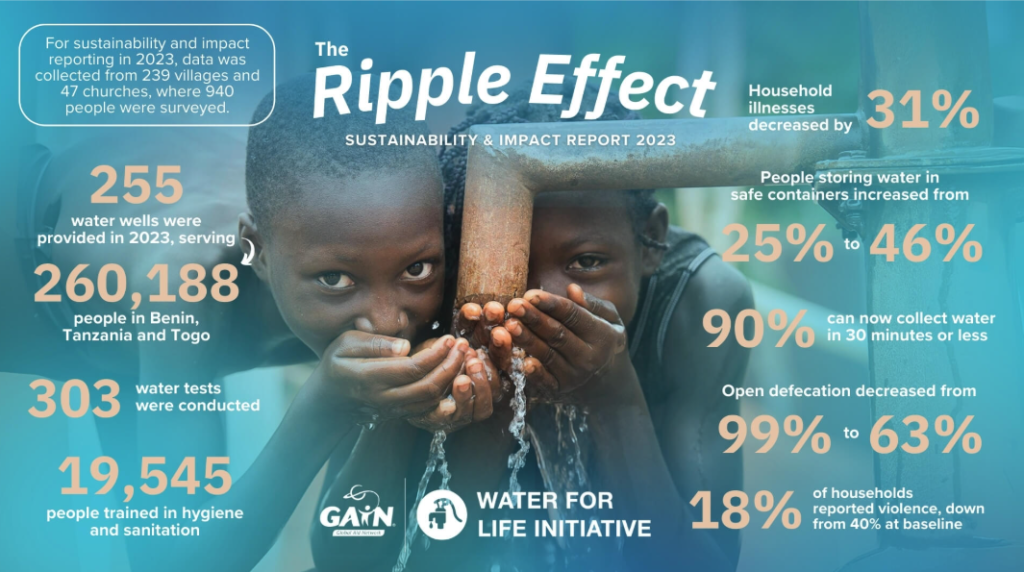
Water is a foundation for human development. Starting with safe water paves the way for holistic sustainable community development.
Here’s the approach of our integrated WASH (Water, Sanitation and Hygiene) program.
Water Committee Training
In every village that a well is drilled, a Water Committee is elected from members of the village. This committee is responsible for the long-term care of the water source and collaborates with other teams trained by GAiN to bring continued development to the community.
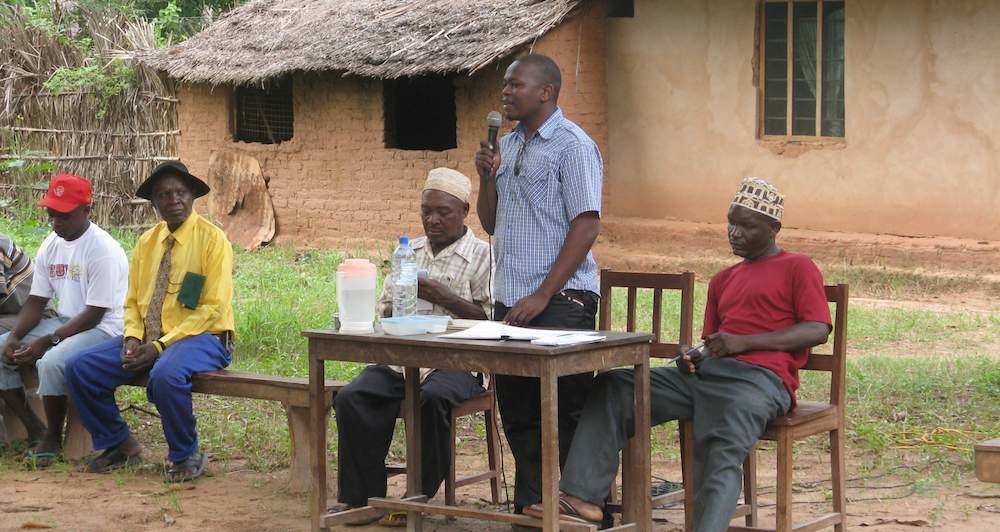
The Water Committee’s presence and training allows the community to take ownership and responsibility for the well, and to become independent of GAiN’s assistance. This allows GAiN to move on to aid and train more villages, and also ensures that the well will become a sustainable resource for the next generation.
The committee is composed of a minimum of six people, and at least 50% of positions must be held by women. GAiN’s equal opportunity policy opens doors for women to other leadership opportunities within their villages, and builds upon the Gender Sensitivity training that we provide.
Hygiene & Sanitation Training
One third of the world’s population does not have access to adequate sanitation, and approximately 80% of illnesses are linked to poor water and sanitation conditions in developing countries. By training those who receive water wells in simple hygiene practices, such as proper handwashing or waste disposal, we can drastically reduce these statistics and begin healthier cultural norms in future generations.
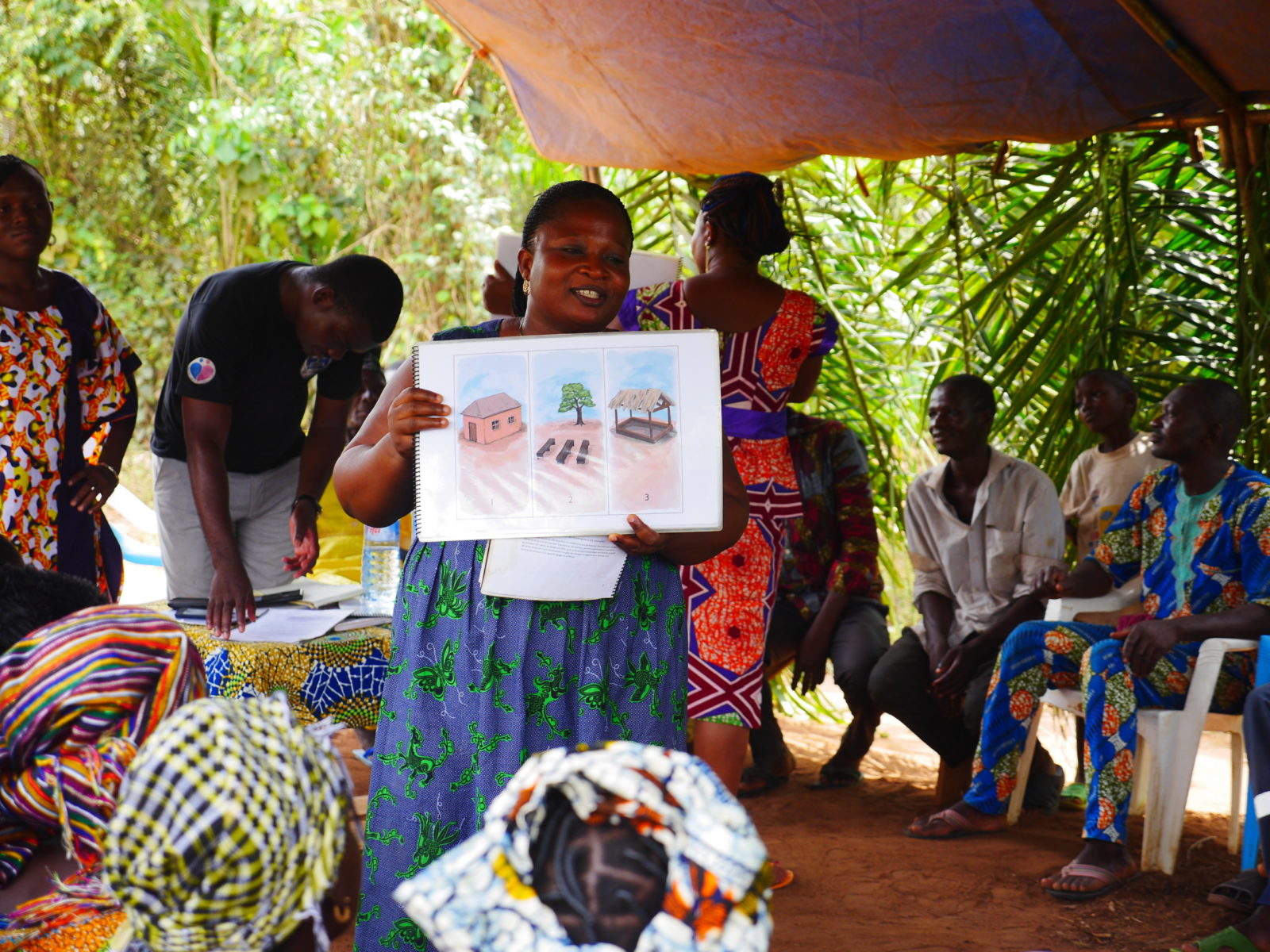
The training works as a facilitated discussion to target unhealthy practices within communities, and devise steps to implement positive changes. Villagers then participate in a variety of activities and discussions, which demonstrate how practices like open defecation, washing hands without using soap, or storing clean water improperly can be harmful to their health, and cause many of the illnesses commonly experienced in their villages.
After these practices have been examined, the group brainstorms simple solutions that can be immediately implemented. One of the most important of these solutions is proper hand washing. Although it seems basic, 1.4 million deaths can be prevented each year by hand washing with soap. Our training teaches critical times to wash one’s hands, such as after using the latrine or before preparing food, as well as the proper technique to completely rid the hands of dangerous bacteria.
Household Harmony Workshop
In many developing countries, women are viewed as second-class citizens. Even though women often have a heavier workload as caretakers of the home, they have very little influence or authority in their house and communities. This unbalanced societal power often leads to fewer opportunities for women for education and work, and can also lead to domestic abuse.
GAiN’s Household Harmony Workshop (formerly known as Gender Sensitivity Training) is designed to open up communication between the sexes, to bring mutual understanding and respect of each others’ roles.
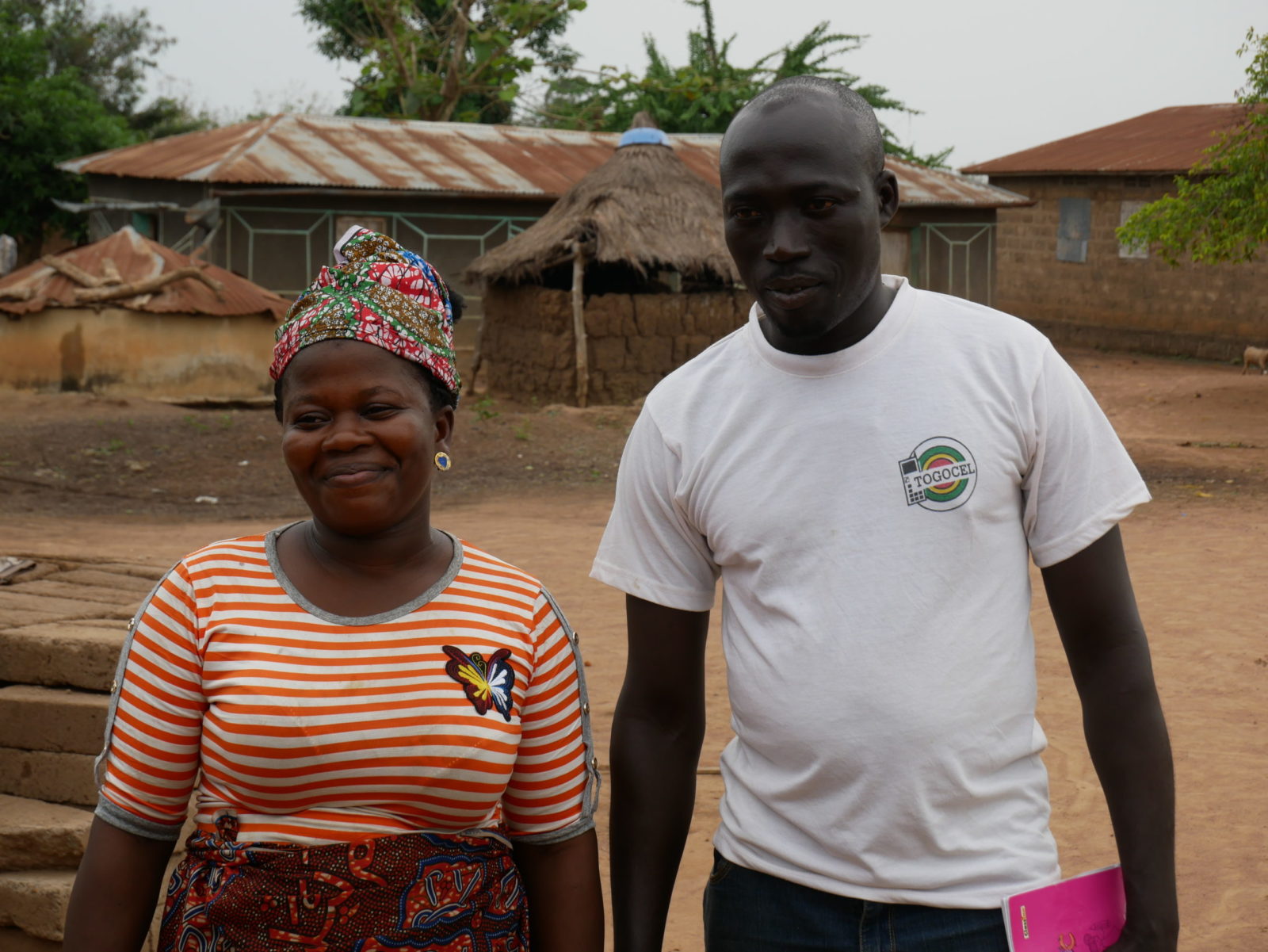
The program starts with employing local experts on gender issues, who have a clear understanding of the problem within the current social and cultural context, to help create and lead training sessions. These sessions facilitate discussions that highlight positive practices between men and women, and expose areas that need improved understanding. Staring in two groups and later coming together in one discussion, both genders discuss the various roles, expectations, and the importance of both genders. Participants also have the chance to share experiences when they have felt empowered or disempowered, and how those experiences relate to their own personal role within their household and village. Finally, brainstorming sessions are led to consider what changes could be made to foster an environment of respect, dignity, and understanding for both genders.
Through interviews and surveys taken during check ups, we have learned that approximately 81% of participants in the training stated they have a better understanding of gender issues, and many women have noted that they are already seeing improvements around their villages. However, it is not only women who have appreciated the training. A man in Trinnonhoue, Benin, stated, “We’ve never had such a meeting to discuss our household problems with our wives. I really appreciate the appeal that is to send our children (girls and boys) to school and keep them in as long as possible.”
When a water well is drilled, it significantly improves the physical health of the village. However, by providing opportunities for further community development such as gender sensitivity training, we are able to impact villages in a much more meaningful way. In countries like Benin and Tanzania, the inequality between men and women is an accepted part of society, and often the men are not aware that women are experiencing hardships as a result of their sex.
Our Gender Sensitivity Training empowers both men and women to be champions of equality in their communities, and opens communications between the genders that were previously unheard of.
Family Health Training
Every year in Benin, approximately 1,500 mothers die from preventable complications during pregnancy, birth, or in the six weeks following birth. In Togo, the infant mortality rate is 77 out of every 1000 surviving baby born. The root cause of many of these deaths is a lack of clean water, and an ignorance of basic health and hygiene practices. Mothers who wash their hands with clean water and soap before handling their newborn children reduce the risk of the child’s death by 44%, however, it is easy to understand how mothers who are used to dirty water, which often does more harm than good, would not know about such a simple practice.
Water for Life Initiative’s Family Health Teams are designed to encourage, educate, and advise families in basic health and sanitation practices.
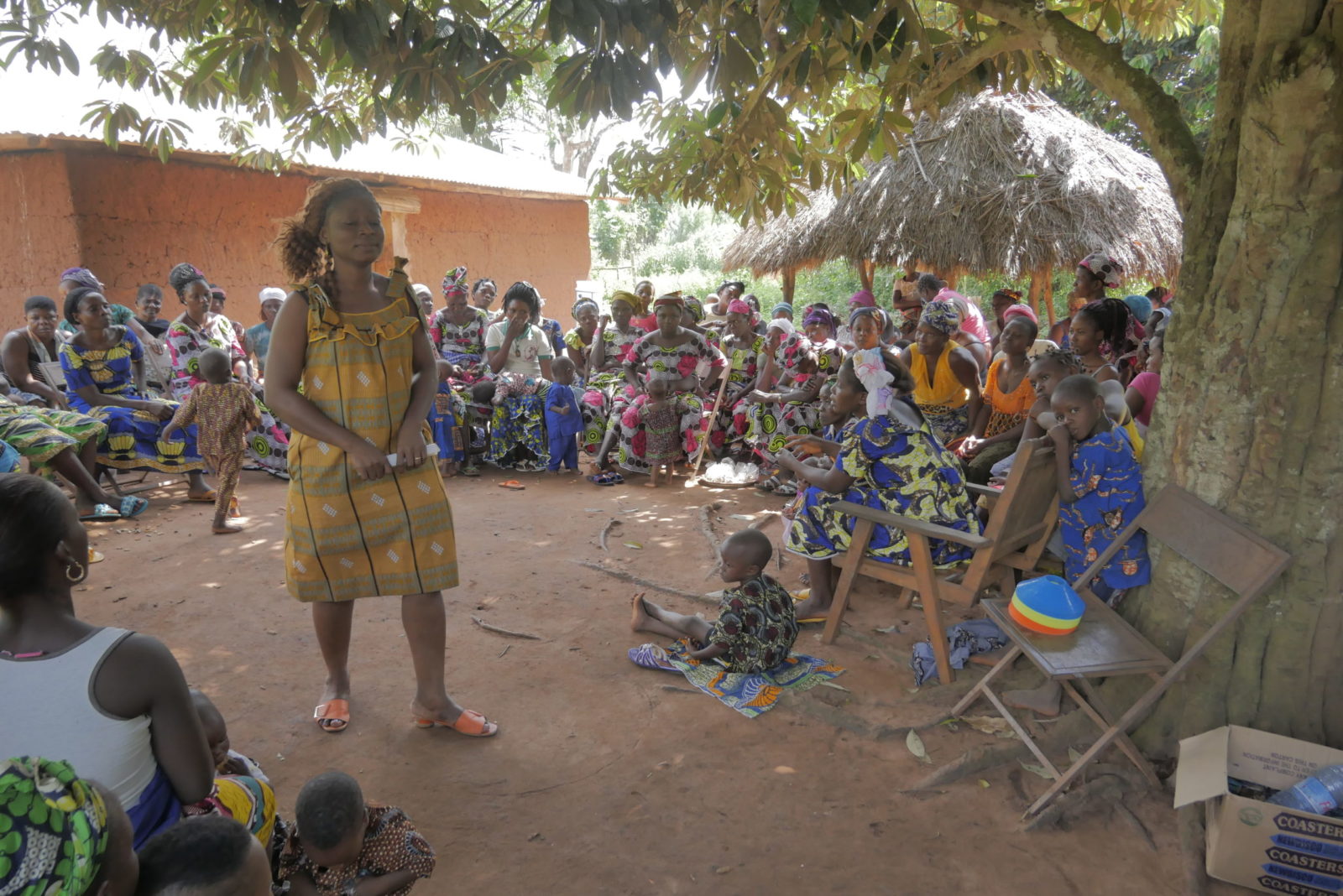
Teams are trained to recognize, treat, and prevent various ailments that can come up in a family’ daily life, from pregnancy to childhood. They are also taught standard procedures to deal with a variety of situations, such as how often a pregnant woman should visit a health centre or when and how to wean a child off of breast milk. Perhaps the most important training teams receive is in how to support and encourage their fellow villages in forming new sanitation habits that can significantly improve their standard of living.
While both men and women in villages are trained in basic family health practices after a well is drilled, the Family Health Teams are composed of groups of five to ten women. This is for two reasons. In rural Benin, women are responsible for water collection, hygiene and sanitation, child rearing and caring for the sick. As a result, they already have the opportunity to positively influence the well-being of the community, particularly children and youth. The Family Health Teams program trains and equips women in the village to actively improve the health and hygiene of their families and communities. Putting women in leadership roles like the Family Health Teams also provides an opportunity for women to develop new skills, and reinforces the principles learned by villagers in the Gender Sensitivity Training.
Regional Repair Representatives
We train individuals as Regional Repair Representatives who then work with the local water committee to keep the water well in good working condition.

Handwashing Stations
Regular handwashing is perhaps one of the most effective ways to prevent waterborne diseases.
We provide a simple handwashing station, complete with soaps and skilled in-country facilitators who educate villagers on handwashing and sanitation issues.
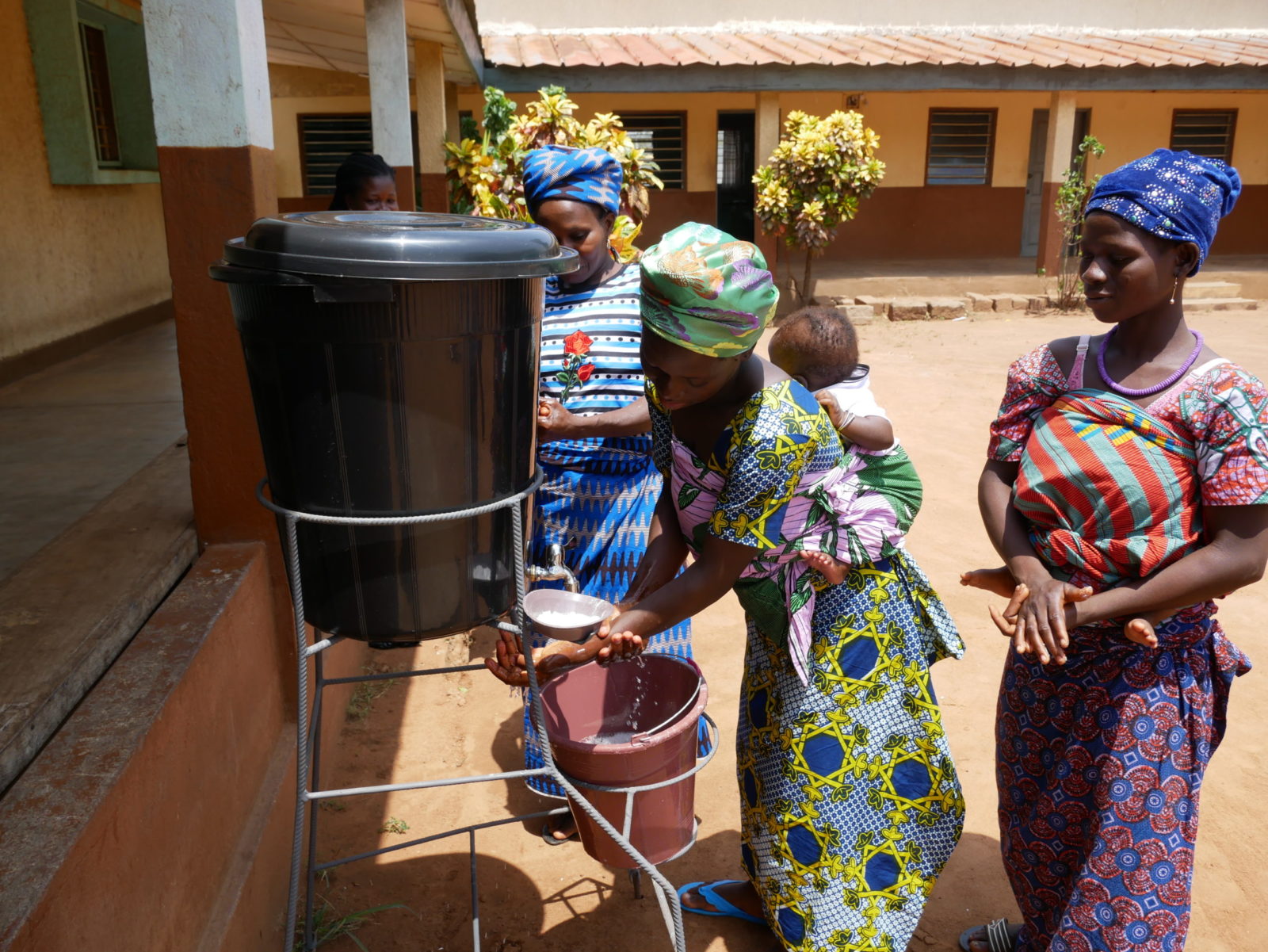
Church Mobilization & Multiplication

The local church permeates throughout everything we do. The local body of believers have a unique role in sustainable development, responding to injustice and facilitating positive social change in their spheres of influence. They demonstrate compassion to those in need and extend true hospitality.
They also help bring the message of God’s love through the JESUS film showings, discipling new believers, training new leaders and planting churches.
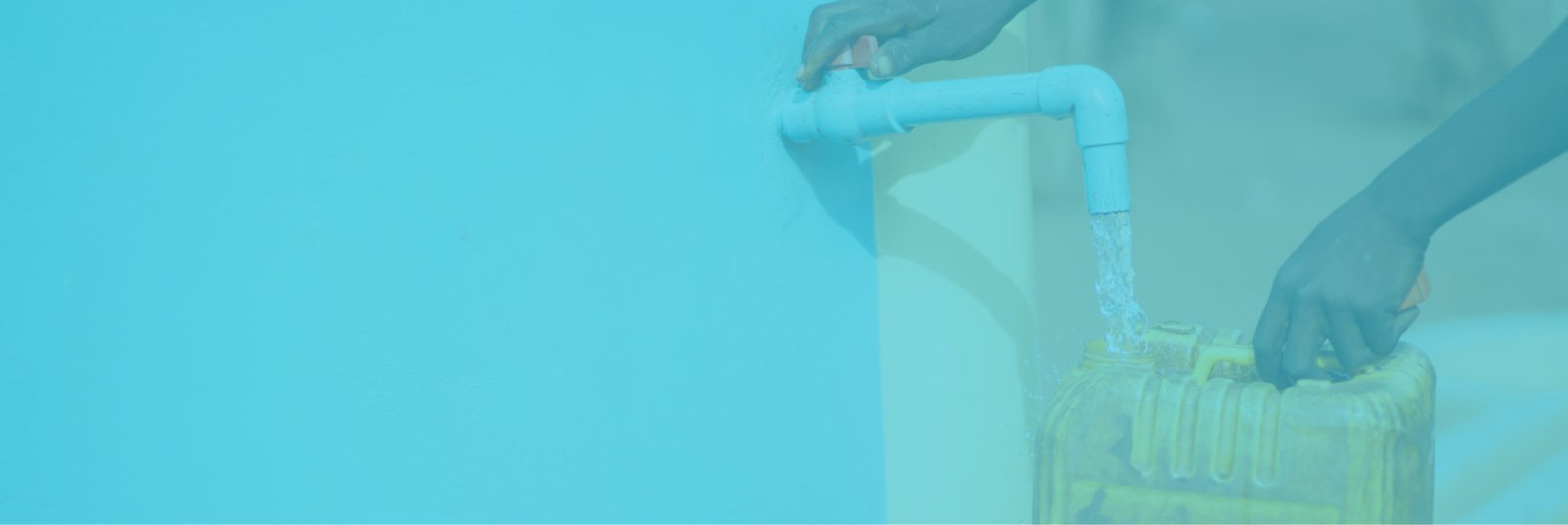
Dreaming Bigger
We dream of a world where human flourishing is restored and where water poverty is eradicated through the power of the gospel.
By 2030, our vision is to provide 10 million people with access to safe water in 10 different countries. At the same time, 5,000 local churches will engaged as the centre for community development.
We believe it’s possible to see a world where physical, spiritual, social and economic brokenness is restored.
Will you join us in making this dream a reality?
Ask away! If you don’t see an answer to your question below, shoot us a message and we’d love to get back to you with an answer.
What is next after my donation?
Upon donation, you will receive a confirmation of your giving within the month.
For donations for $5,000 or above, we will connect your donation to a specific village that needs a well and we will send you a well assignment report, telling you of all the details of the village. You will receive this within four months after your donation date.
For any donations of $13,000 (donation of one full well), we will create an online donor page with the videos of your well, GPS coordinates of the well, the sights and sounds of the actual village that your well is located and any interviews of villagers that were conducted at our well visit. This process could take any time from 8-15 months.
What is included in my report?
Upon donation of a well, a ‘well assignment report’ will be sent to you listing all the facts and details on the well and the village that you have an impact. These facts include GPS coordinates, well statistics like depth, flow rate, type of pump being used, village facts like demographics, population and community activities like sanitation and hygiene and borehole committee training sessions. It also includes a map showing where the village is in relation to the rest of the country.
What am I paying for when I sponsor a water project?
The $13,000 covers
- the cost of the construction of one deep-capped water well, which includes salaries for our drill and pump installation crew, construction materials like pumps, casings, cement for the concrete pad, our regular machine maintenance costs, fuel for moving our machines to the site, and periodic water quality testing like total dissolve solids, nitrite/ nitrate content, bacteria and pH testing.
- our programs for the water committee and hygiene and sanitation training
- working with the local church to train leaders, show the JESUS Film and follow up with new believers
Why could it take up to 15 months to get my video?
While we want to report to our donors as fast as possible, we also want to make sure that the well and all the auxiliary programs work. The amount of time is critical for us to ensure that our sustainability components are in place and allowing time for the training to take place. Our regular site visits takes a bit of time to complete. Sometimes when it’s raining season, roads are just not accessible, so we have to wait until the drier season to go to the village to visit. Because it is highly tailored to the donor, the production time is needed.
(Note: this is an average time frame and this report is only for those that gave to a full well.)
Can I pick the country where my money goes?
You may give your preference of one of the countries that the WFLI works in, however, if you do not have a preference, the funds will be given to the project that is needed the most. In an unlikely event where your donation has to be re allocated due to unpredictable circumstances, we will contact you to let you know of the situation.
Do I get to decide where the well will be?
Since we work closely with local governments in many countries to determine where we should best deploy our crew there and the fact that we have local staff there that access the situation to determine where best to put the next water access point, donors are unable to pick where the well is actually provided.
What can go wrong?
There are a number of factors that can come into play. Although not frequent, we do encounter some areas where we have dry wells or wells that is producing water with high salinity, in that case, we will try our best to find another location close to the village.
The areas that we work are often far away from the city, especially during the rainy seasons, our crew may have a harder time to reach to the particular location. There are also rare occasions of machine failure which may delay the pace of providing a well.
After the well is provided, there are a few occasions where a pump or pipe will break, due to normal wear and tear. In which case, the borehole committee of that village will notify our regional repair team to come for repair.
We are committed to give you not just a water well, but a working one. We will try our best to resolve the problems that might prevent villages to have clean water.
How do you address the issue of sustainability of these wells?
Our long-term presence and commitment to the countries that we are operating in ensures that we have ongoing contacts and follow-ups to check and see whether these wells are working properly.
The water committee concept is a good example of empowering the local villagers so that they know how to keep the well.
Each committee charges a small fee (often they are a few cents) per use/per bucket to enable the village to repair a broken well, because they have the means for repair.
We have also trained and equipped regional repair teams who are from the village with tools and knowledge to repair broken wells, and they could service other areas.
We use reliable and robust technologies in our drilling and pump so that one can get the materials for the parts for repair in country and not rely on imports.
What are some of your learnings over the 10+ years?
The Benin and Togo Maternal, Newborn and Child Health Project commenced on March 29, 2016
with the completion date of September 30, 2020. The project is a collaboration between Global Aid Network Canada (GAiN) and Global Affairs Canada (GAC), and contributes to the reduction of maternal and child mortality in the targeted regions of Benin and Togo. The project has positively impacted 250,329 villagers (80.9% being women and children) by providing a clean water source to 281 communities in Benin and Togo. The ultimate outcome set for this project is a 10% reduction of stunting in children under five years of age. A concentric health clinic model was implemented, which involved the delivery of multiple complementary interventions such as providing safe water, sanitation and hygiene (WASH) resources, village and clinic level training, equipping village champions, and community social marketing campaigns. The focus of this initiative is that pregnant women, newborns and children under 5 will have improved utilization of essential health services, and increased absorption and consumption of nutritious foods.
Throughout the project, the teams were able to streamline and improve data collection
methodologies so that managers could provide more oversight to their teams and track results.
Additionally, improvements were made to water quality tests based on learnings in Year Four. Continuous staff development was an important aspect to project management and implementation. The project benefited from having competent managers and board members who were able to effectively implement all the project objectives and who demonstrated excellent leadership adding to the success of the project. The gender-balanced boards of directors and data collection teams ensured that issues affecting women were adequately addressed in the project activities, and that the objectives focused on development that worked for the whole population.
Financial management concerning budgeting, procurement and allocation of resources provided
more opportunities for learning as it pertained to the handwashing stations, clinic worker trainings and the community social marketing. In addition, better management of inventory for supplies to better mitigate production and procurement delays were key learnings to be implemented in future projects.
The project design was successful in its impact on communities. However, some design aspects
could be adjusted for future projects, such as putting more resources into the recognition and training of champions to encourage their leadership and involvement. Some of the community trainings were also identified as being too long for a single sitting, and the local partners recommended having multiple, shorter training sessions over a longer period of time as a better mode of delivery.
The design of the gender sensitivity forums proved to be an effective way to facilitate community
ownership of community-specific gender issues. The combination of the same-gender discussion forums, larger group discussions and activities discussing the distribution of household activities, childcare, vocational activities, and access and control of resources created opportunities for important dialogue. The importance of contextualization also became apparent, as certain topics such as gender roles and gender-based violence appeared to be sensitive subject matter.
What is your Theory of Change for the Water for Life Initiative?
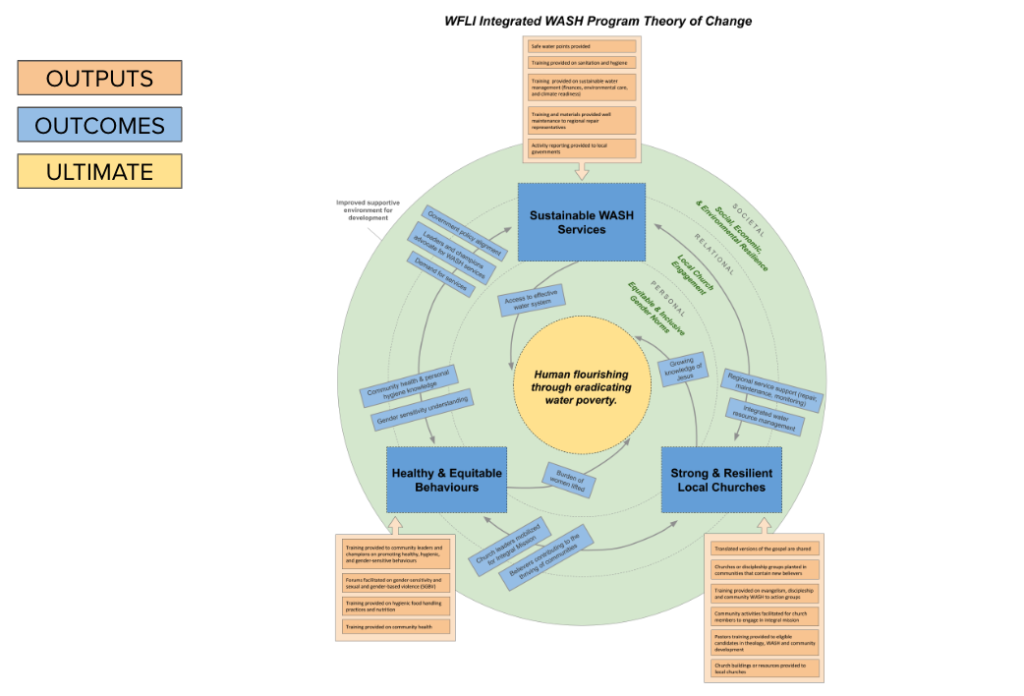
Read about the impact you’ve had in transforming lives – physically, spiritually and emotionally by providing access to clean water.
Give the gift of health, time, education, safety, freedom, and life
We dream of a world where water poverty is eradicated through the power of the gospel and human flourishing is restored. Will you join us?

